New Perceptions of Ancient Commerce Driven by Underwater Ancient Site Investigations: A Case Study of Xinfeng River Basin
Abstract
1. Introduction: Historical, Geographic, and Cultural Profile of Wanlv Lake in the Xinfeng River Basin
1.1. Geography and Location
1.2. Two Main Sources of Dongjiang River
1.2.1. Main Tributaries of Upper Dongjiang River—Outer and Inner Rivers
1.2.2. Xinfeng River and Wanlv Lake
1.3. Ancient Roads
1.3.1. Guangdong-Jiangxi Ancient Road
1.3.2. A Transportation Network with Both Land and Water Routes
1.4. A Land of Fish and Rice Nurtured by Ancient Waterways
1.5. A Representative Region of Hakka Sijiaolou Buildings and a Gathering Place of Hakka People
2. Materials and Methods: Survey of Underwater Cultural Relics in Wanlv Lake
- The original Guangdong–Jiangxi Ancient Road continued southwestward from Dengta and Shuangjiang and disappeared in Wanlv Lake in Dou’ao. Therefore, the first investigation line started from where the Dou’ao post road disappeared into the lake and stretched toward the southwest.
- The former Guangdong–Jiangxi highway stretched from the current Xingfeng River fishing pier, turned to the north, and disappeared into Wanlv Lake. Therefore, we arranged an investigation line from the pier to the north.
- The original Xingfeng River was cut off from the dam and continued in the northeast direction; thus, an investigation line was arranged from the dam to the lake area of the Xingfeng River.
- According to an ancient schematic map, the Xingfeng River diverged in the old Huilong Town, with one branch reaching the ancient town of Guling to the west and the other reaching the ancient town of Nanhu to the east and turning northward and then westward to the ancient town of Xichang. Therefore, investigation lines were arranged based on this information.Investigative equipment:Surveys were conducted using the EdgeTech 4205 side-scan sonar (from Edge Tech Inc. in West Wareham, MA, USA).Data-acquisition parameters:Dual-frequency with a width of 200 m.Data-processing flow:
2.1. Survey of the Remains of Linear Ancient Post Roads
2.1.1. Onshore Survey
2.1.2. Underwater Survey
- running westward from Huilong to Guxu and Xichang;
- running northward from Huilong, with a branch running westward to Lixi;
- then running northward to Lianping and turning back to a land route.
Xiaodong Ancient Road
Dongping Ancient Road
Xialin Ancient Road
2.2. Survey on Underwater Linear Ancient River Courses
2.3. Historical Sites of Docks and Ferries
2.4. Ancient Bridges
Nanhu Underwater Ancient Wooden Bridge
2.5. Survey of Other Underwater Relics
2.5.1. Towns and Villages
2.5.2. Villages, Farmlands, and Tea Farms
2.5.3. Hakka Residential Houses
3. Results: Analysis of the Findings and Archaeological Understanding
- We have established historical transportation sites, including those of ancient roads, bridges, docks, and ferries.
- We have determined the main channel and tributaries of the Xinfeng River; villages, towns, farmlands, and tea farms distributed along the main channel and tributaries of the Xinfeng River.
4. Conclusions and Prospects
Author Contributions
Funding
Data Availability Statement
Acknowledgments
Conflicts of Interest
| 1. | Wang Yuanlin: The Ancient Road of Longchuan. |
| 2. | Same as Note 3. |
| 3. | Tan Weilun and Zeng Hanxiang: Traditional Society and Local Customs in Heyuan. |
| 4. | According to page 49 of the “Investigation Report of Guangdong-Jiangxi Ancient Road” compiled by the Guangdong Province Nuclear Industry Geological Bureau’s 292nd Brigade, “three sections of well-preserved ancient roads have been found in Dou’ao and near the Xinfengjiang Reservoir, with their lengths ranging between 150 and 500 m and widths up to 2 m”. This ancient road is called the “Dou’ao Ancient Road”. After the water level dropped, the ancient road originally submerged underwater was exposed. The original joint between the ancient road and the lake was also found near the current lake. |
| 5. | A photo of the Doubei Village Ancient Road could be found on page 50 of the “Investigation Report of Guangdong-Jiangxi Ancient Road” compiled by the Guangdong Province Nuclear Industry Geological Bureau’s 292nd Brigade. From the photo, it could be seen that the road shared an identical pavement approach with the water entry point of the Dou’ao Ancient Road, with slight differences in the width. The two roads are not far from each other, and should belong to the same road section constructed in the same period. |
| 6. | The place where the “Yuantan Ferry Stele Inscription” was found is not far from the Dongping Ancient Road near the ruins of a village very close to the river. |
| 7. | According to the “Investigation Report of Guangdong-Jiangxi Ancient Road” compiled by the Guangdong Province Nuclear Industry Geological Bureau’s 292nd Brigade, the main road of Guangdong–Jiangxi Ancient Road in Heyuan generally runs in a north–south direction. It leads from Heping in the north to Lianping in the south, arriving at the urban area of Heyuan after passing through the three towns of Shuntian, Jiantou, and Shuangjiang of Dongyuan. Both the main route and the branch lines of the Ancient Road passed through Shuangjiang. Judging from its location, the Xialin Ancient Road should belong to the main route. |
| 8. | The Chronicles of Heyuan, compiled by the Heyuan Local Chronicles Editorial Committee. |
| 9. | From the topography and the remains of the site, a preliminary judgment could be made that this place used to be a dock; however, additional evidence is required for verification. |
| 10. | In the Qing Dynasty, Chen Zhangyi of Heyuan County wrote a poem titled “Longjin Evening Ferry”: “A river surrounds the city with the ancient ferry of Longjin. At sunset, boats float on the river. Across the bank, porters are climbing the mountain wearing bamboo hats. Don’t eulogize sufferings. Let’s unite with each other to reach our destination”. |
| 11. | “Guyun” is an ancient name. According to a copy of “The Chronicles of Heyuan County: Volume 15,” compiled by Peng Jungu and edited by Lai Yiping, published in the 13th year of the Tongzhi reign in the Qing dynasty, Guyuan is located 20 lis away from the downtown to the east. |
| 12. | According to a copy of “The Chronicles of Heyuan County: Volume 15”, compiled by Peng Jungu and edited by Lai Yiping, published in the 13th year of the Tongzhi reign in the Qing dynasty, the Liucheng Ferry was located to the northeast of downtown Heyuan with a distance of 120 lis. Situated in Liucheng town, it was initiated by Chen Zixue with a rent of over 90 dans. With an approval from the county’s head official surnamed Wang, a stele was set up on the left side of the Tianhou Temple. |
References
- Leong, S.-T.; Wright, T.; Skinner, G.W. Migration and Ethnicity in Chinese History: Hakkas, Pengmin, and Their Neighbors; Stanford University Press: Redwood City, CA, USA, 1997. [Google Scholar]
- Campbell, G. Origin and Migration of the Hakkas. Chin. Rec. 1912, 43, 473–480. [Google Scholar]
- Xie, G.; Zhou, Y.; Liu, C. Spatial distribution characteristics and influencing factors of Hakka traditional villages in Fujian, Guangdong, and Jiangxi, China. Sustainability 2022, 14, 12068. [Google Scholar] [CrossRef]
- Cervenka, P.; De Moustier, C. Sidescan sonar image processing techniques. IEEE J. Ocean. Eng. 1993, 18, 108–122. [Google Scholar] [CrossRef]
- Blondel, P.; Blondel, P. Sidescan sonar data processing. In The Handbook of Sidescan Sonar; Springer: Berlin/Heidelberg, Germany, 2009; pp. 49–84. [Google Scholar]
- Li, F.; Lu, G.; Zhou, X.; Ni, H.; Xu, C.; Yue, C.; Yang, X.; Yang, J.; Feng, F.; Fang, F. Elevation and land use types have significant impacts on spatial variability of soil organic matter content in Hani terraced field of Yuanyang County, China. Rice Sci. 2015, 22, 27–34. [Google Scholar]
- Lin, R.; Fan, Y.; Zhang, D. Landscape Feature Extraction and Floristic Division of Traditional Villages in the Minjiang River Basin. South Archit. 2022, 1, 54–60. [Google Scholar]
- Yang, X. Research on hakka enclosed houses in guishan county of qing dynasty. Ph.D. Thesis, South China University of Technology, Guangzhou, China, 2011. [Google Scholar]


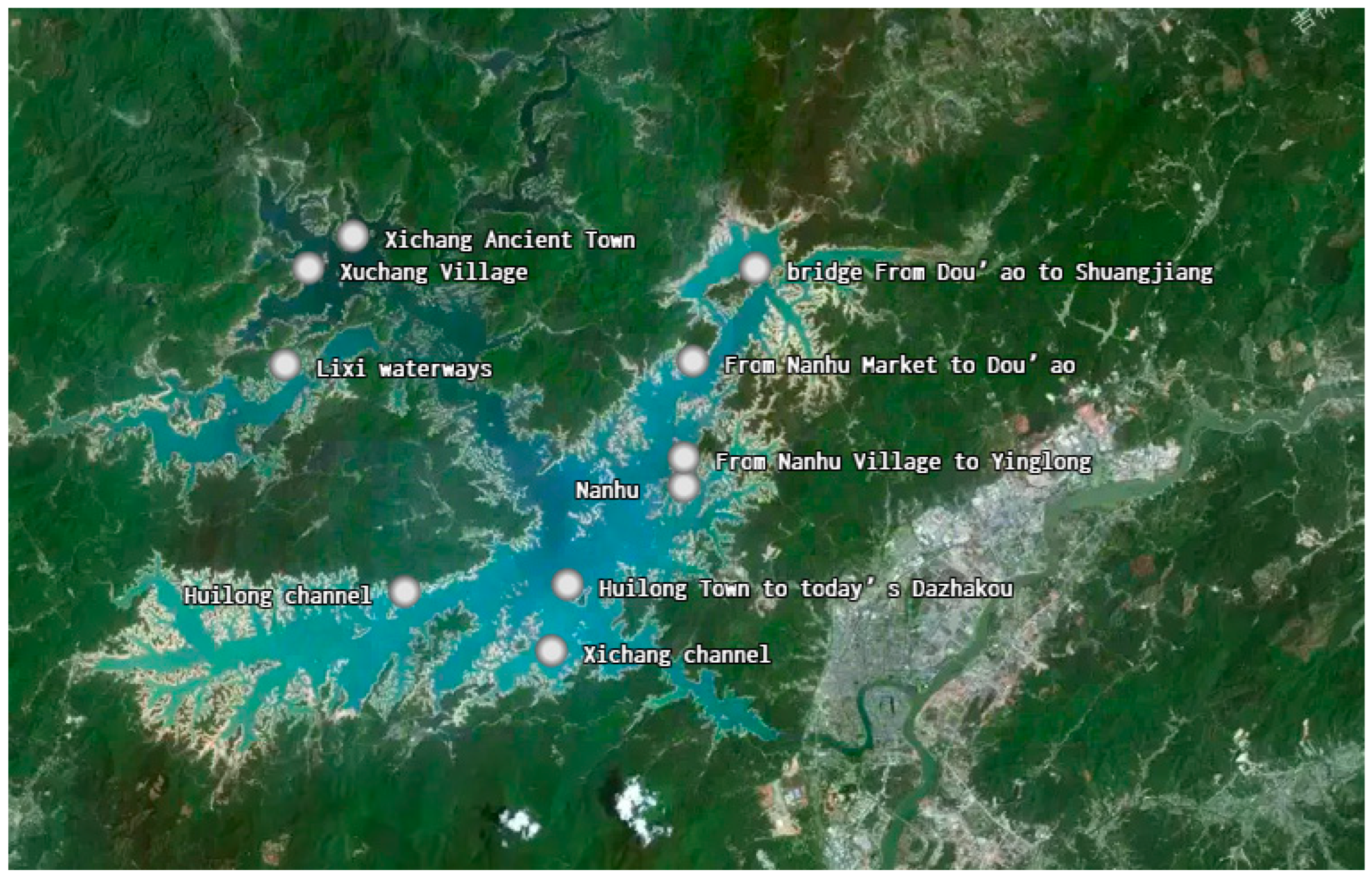
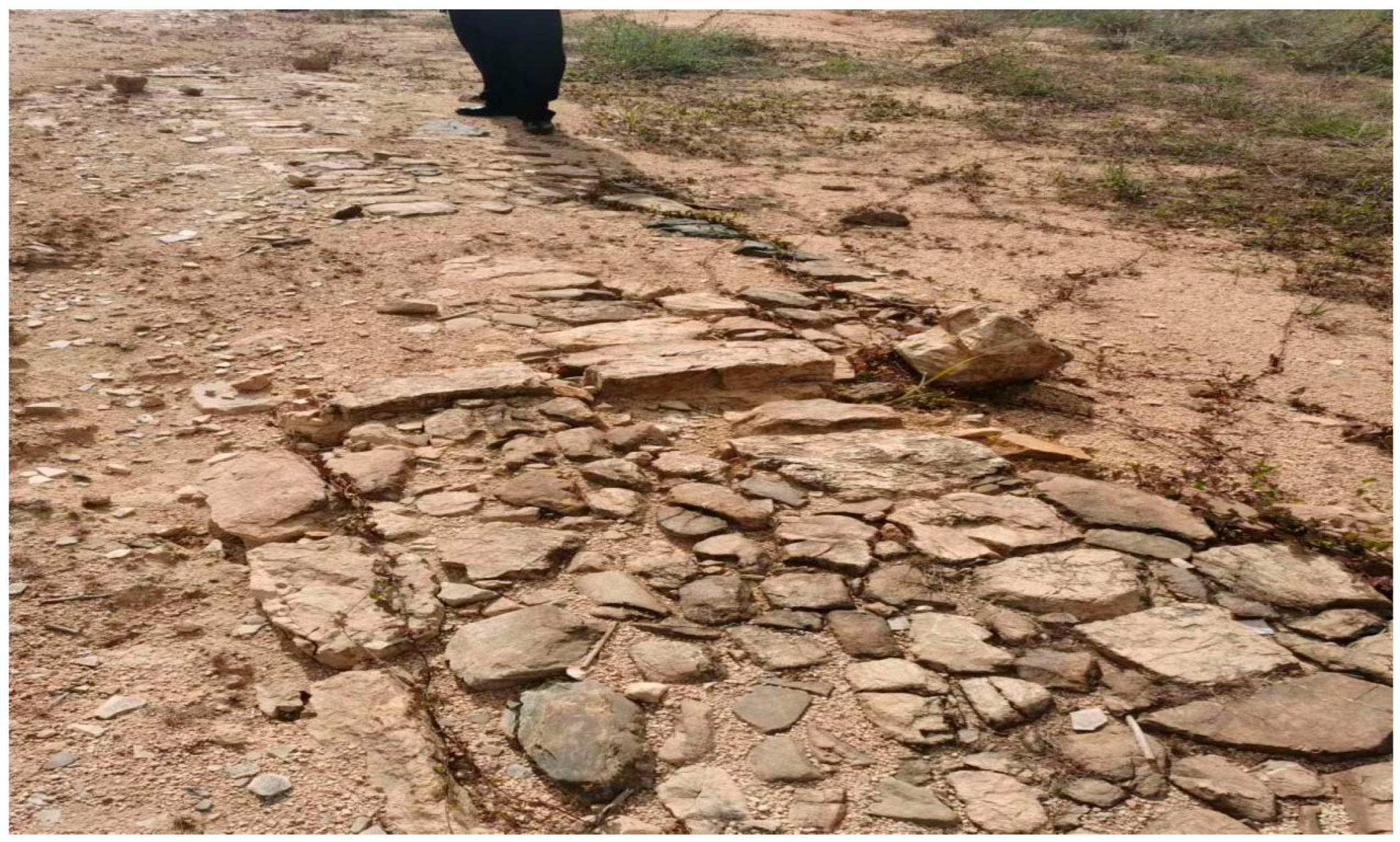



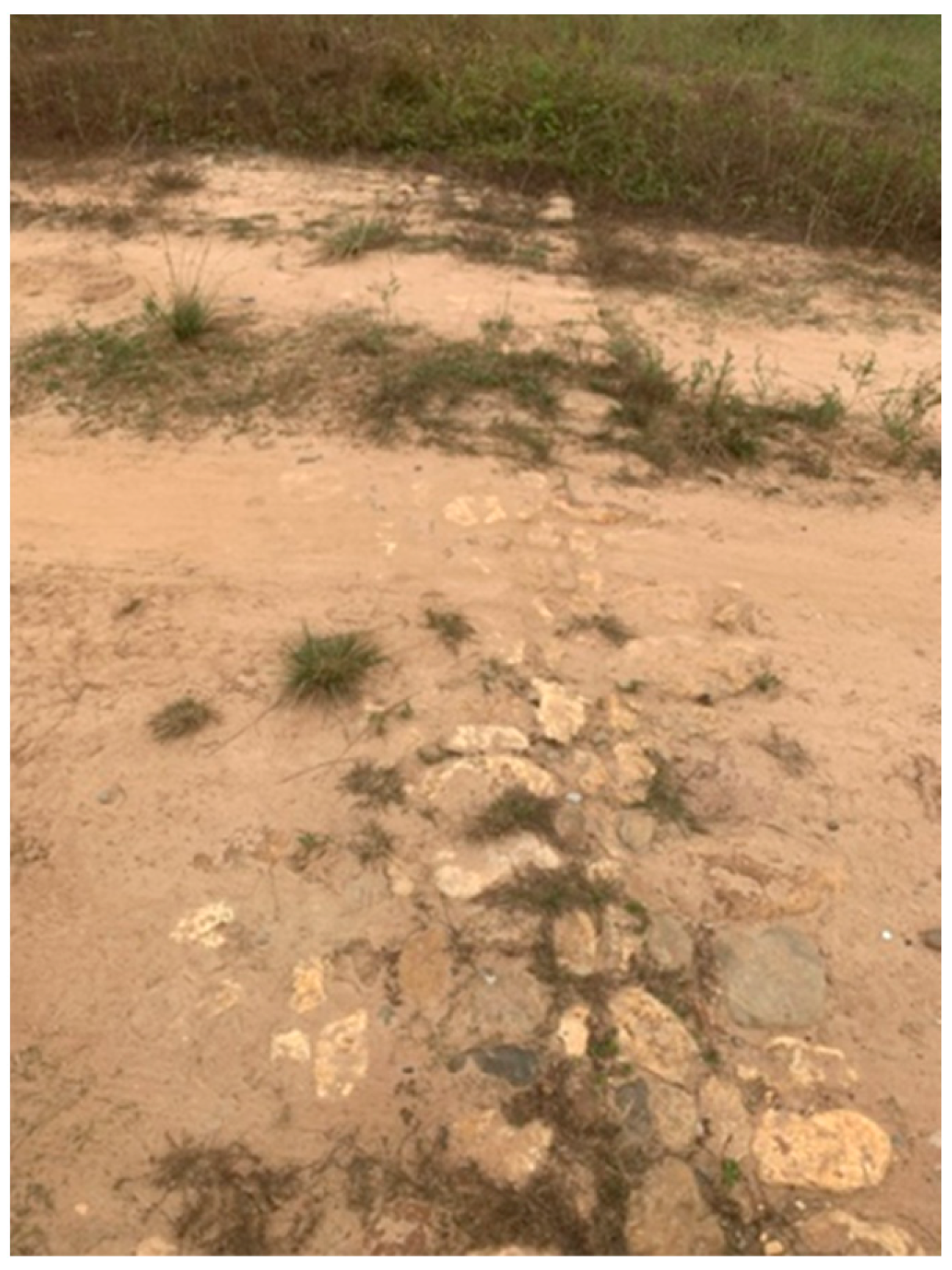
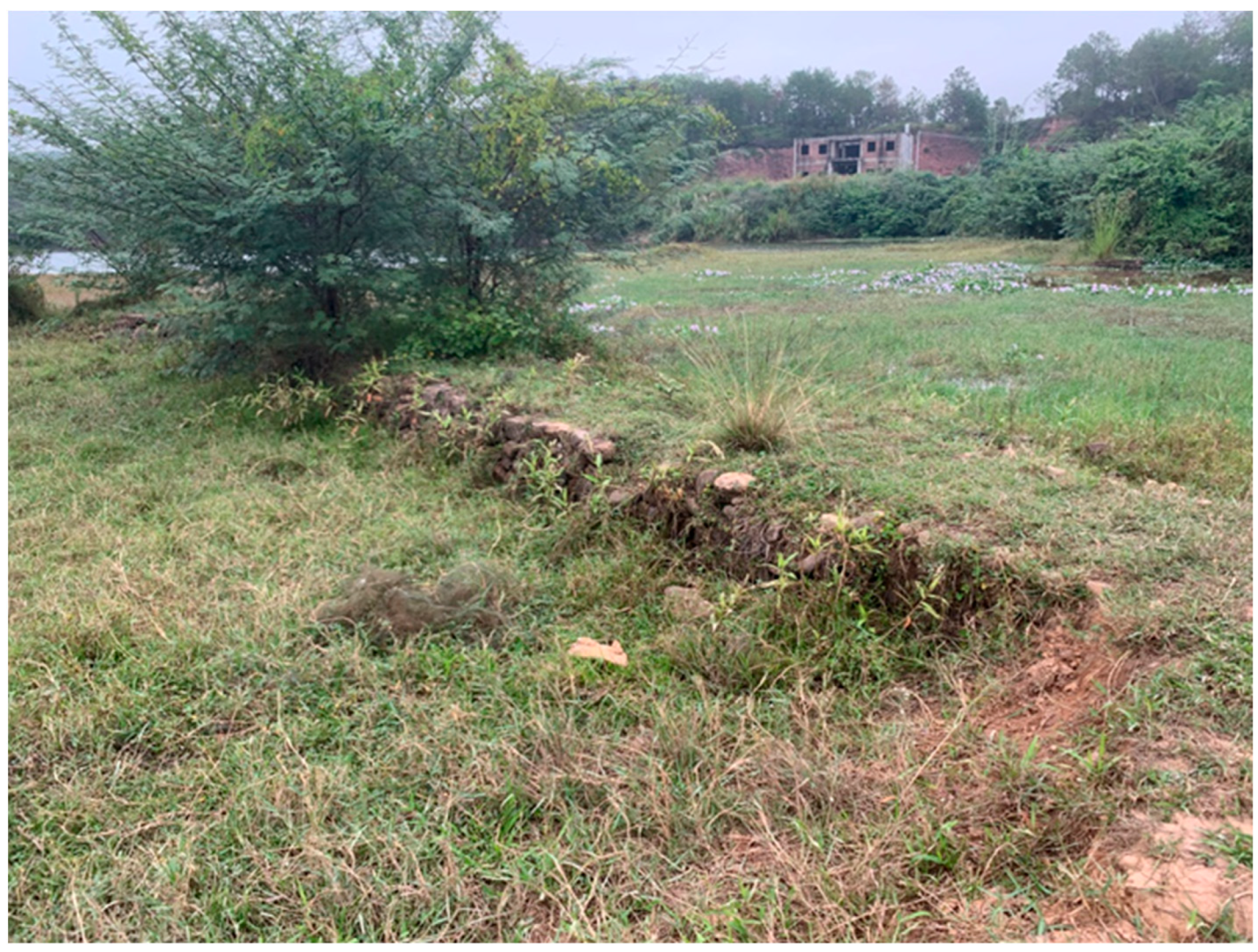


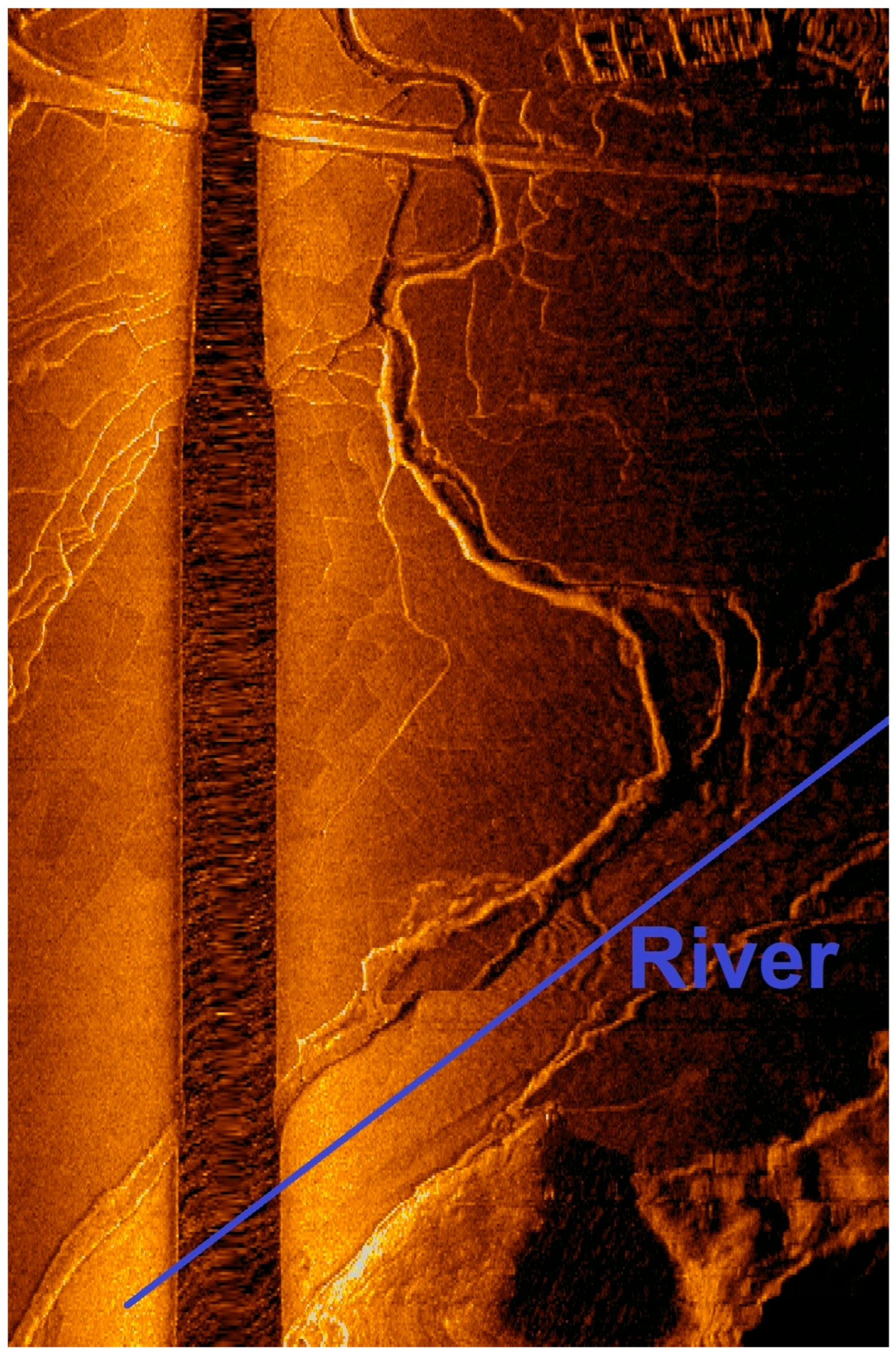
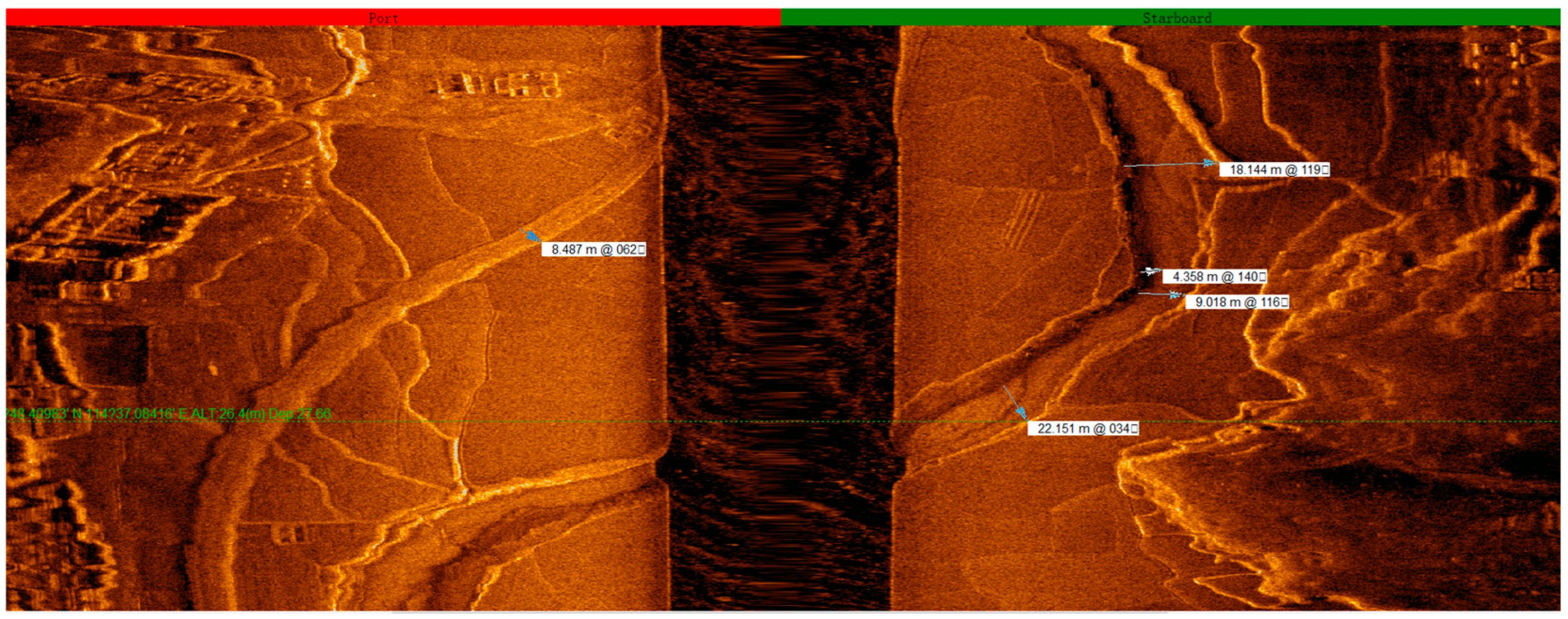

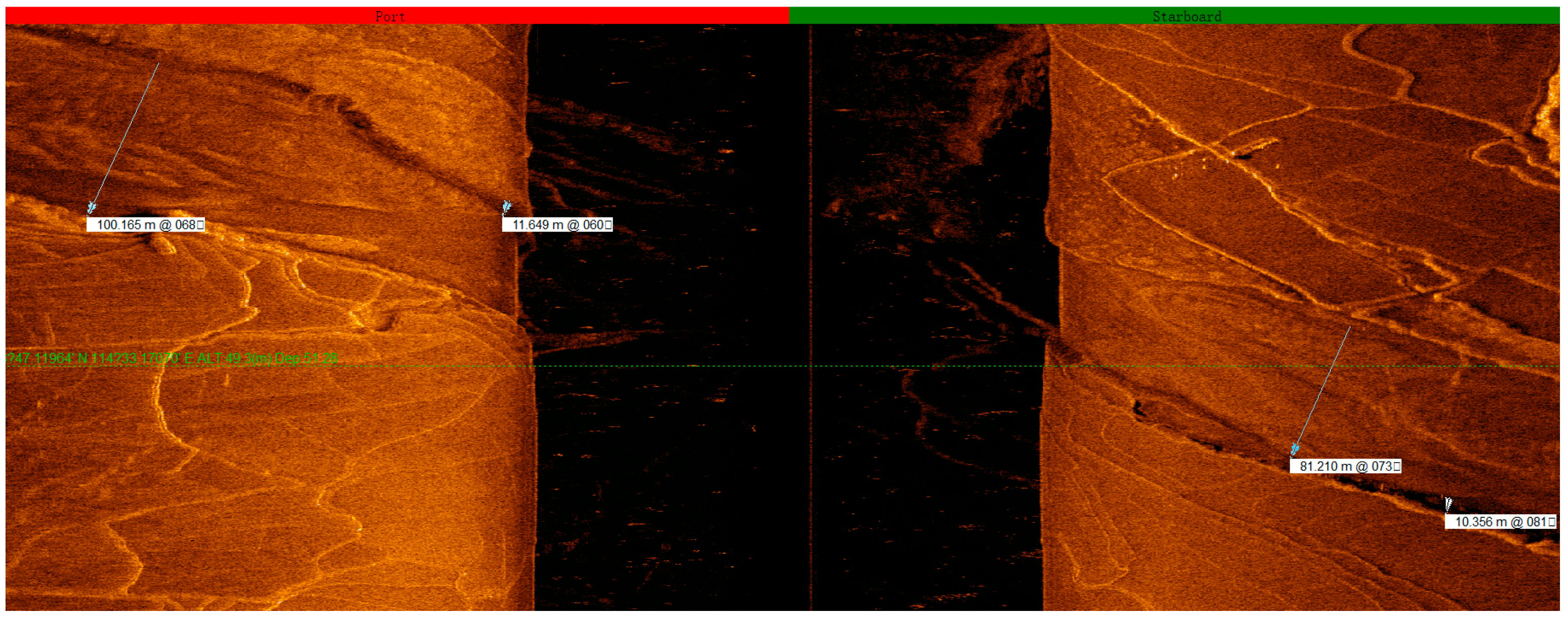
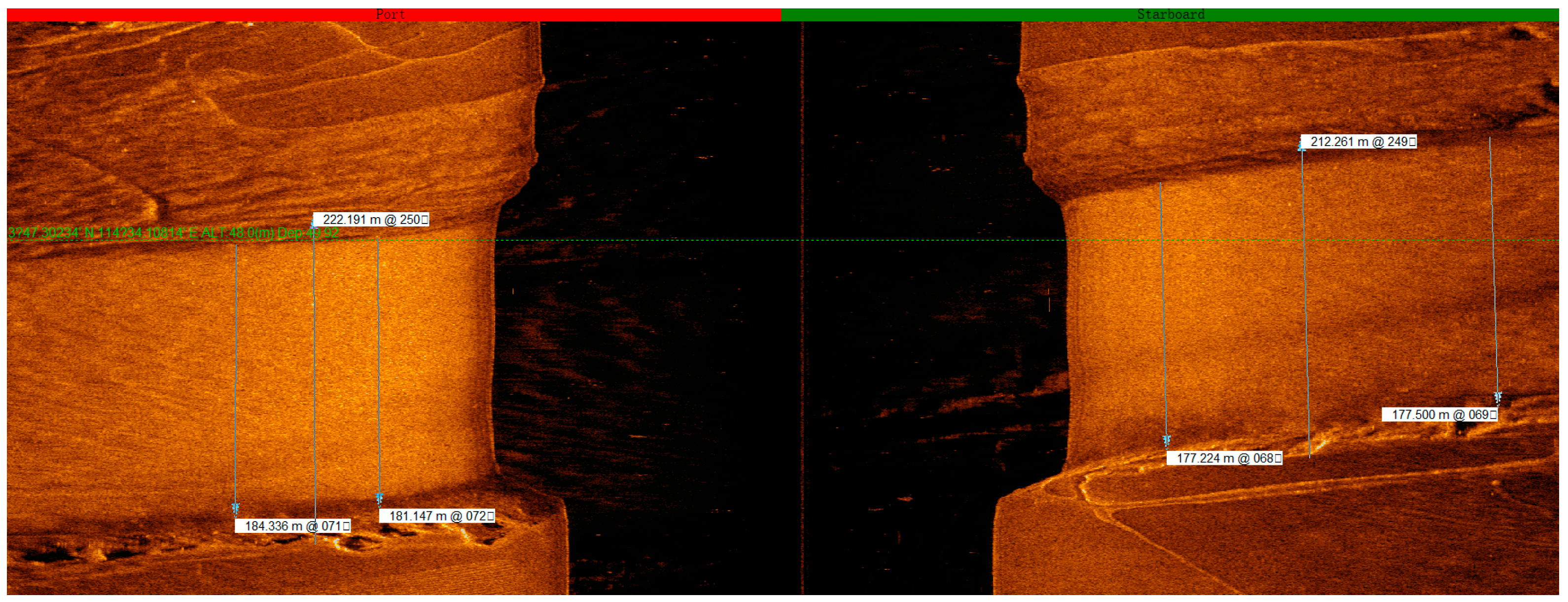

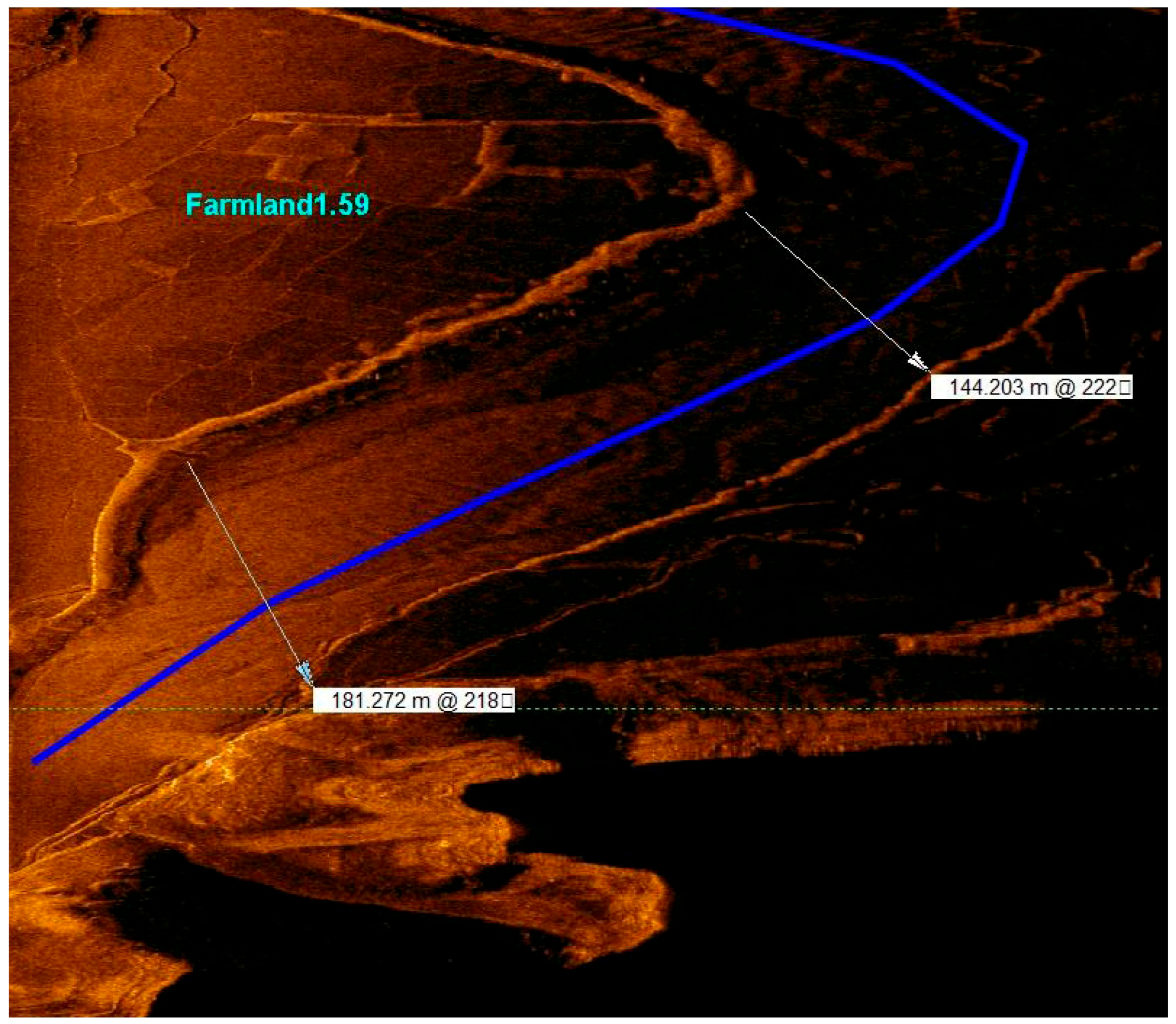
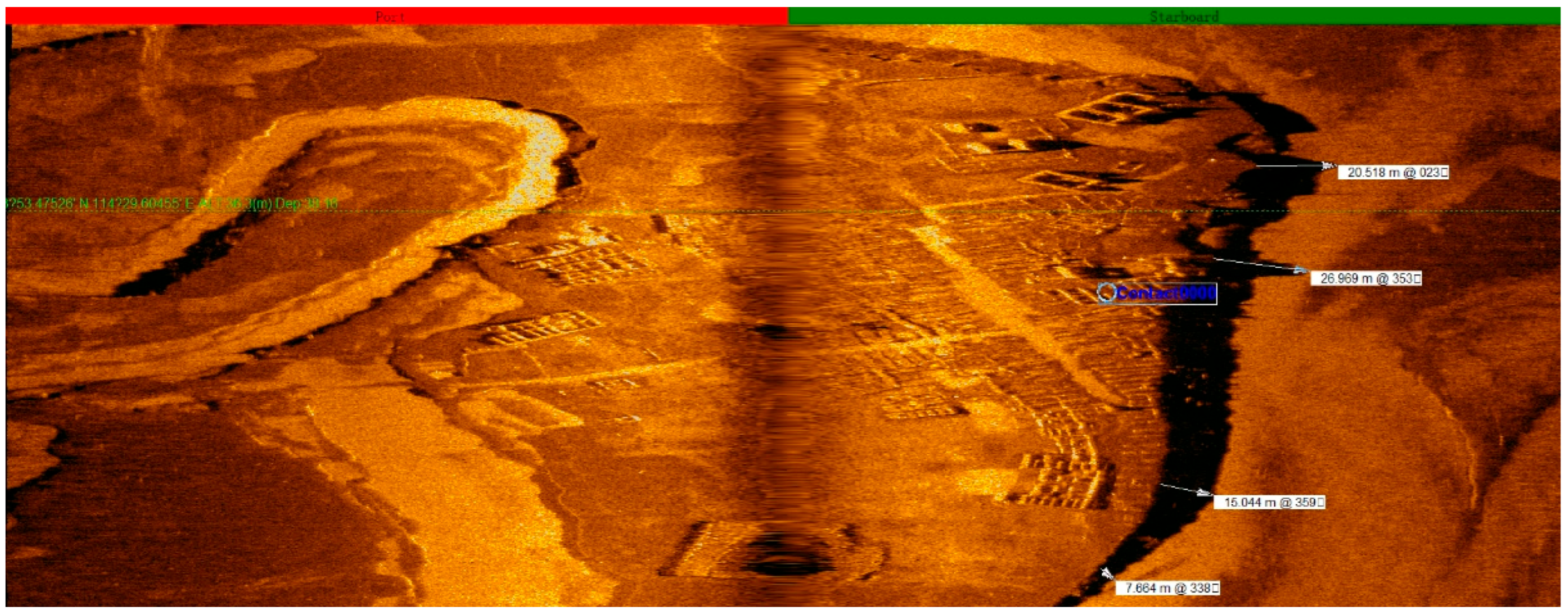

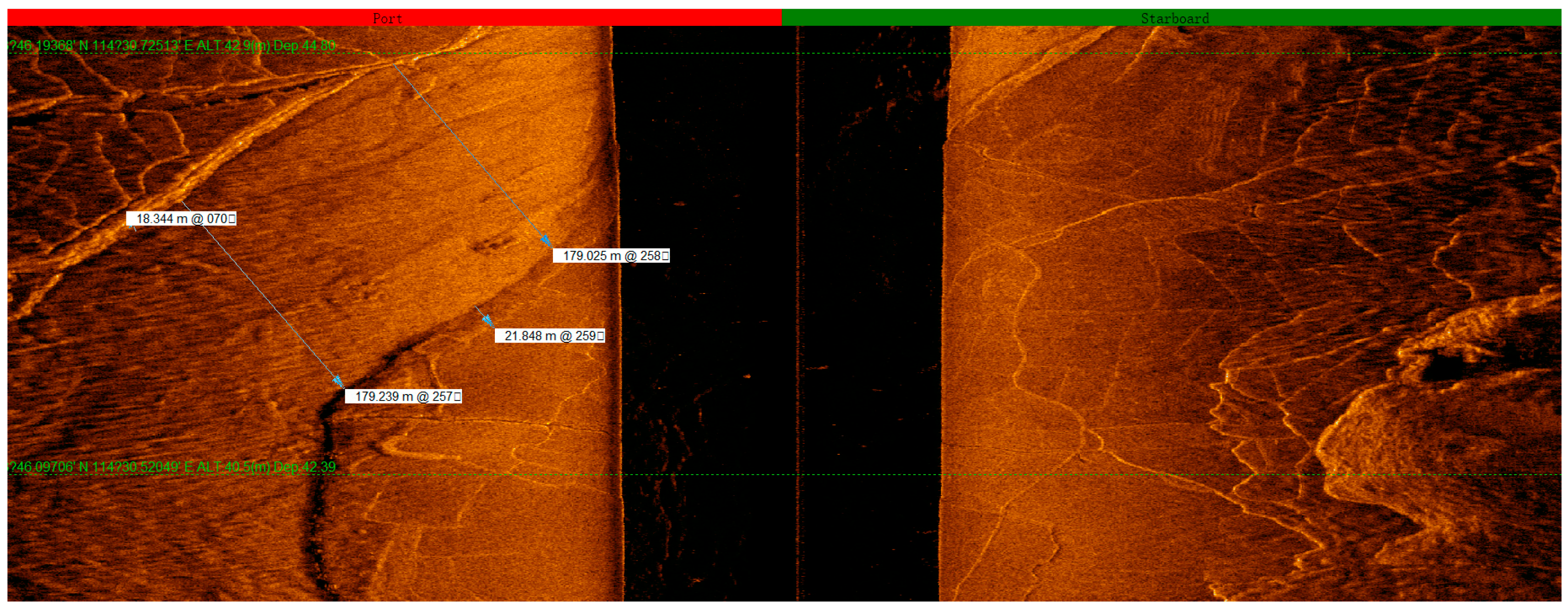


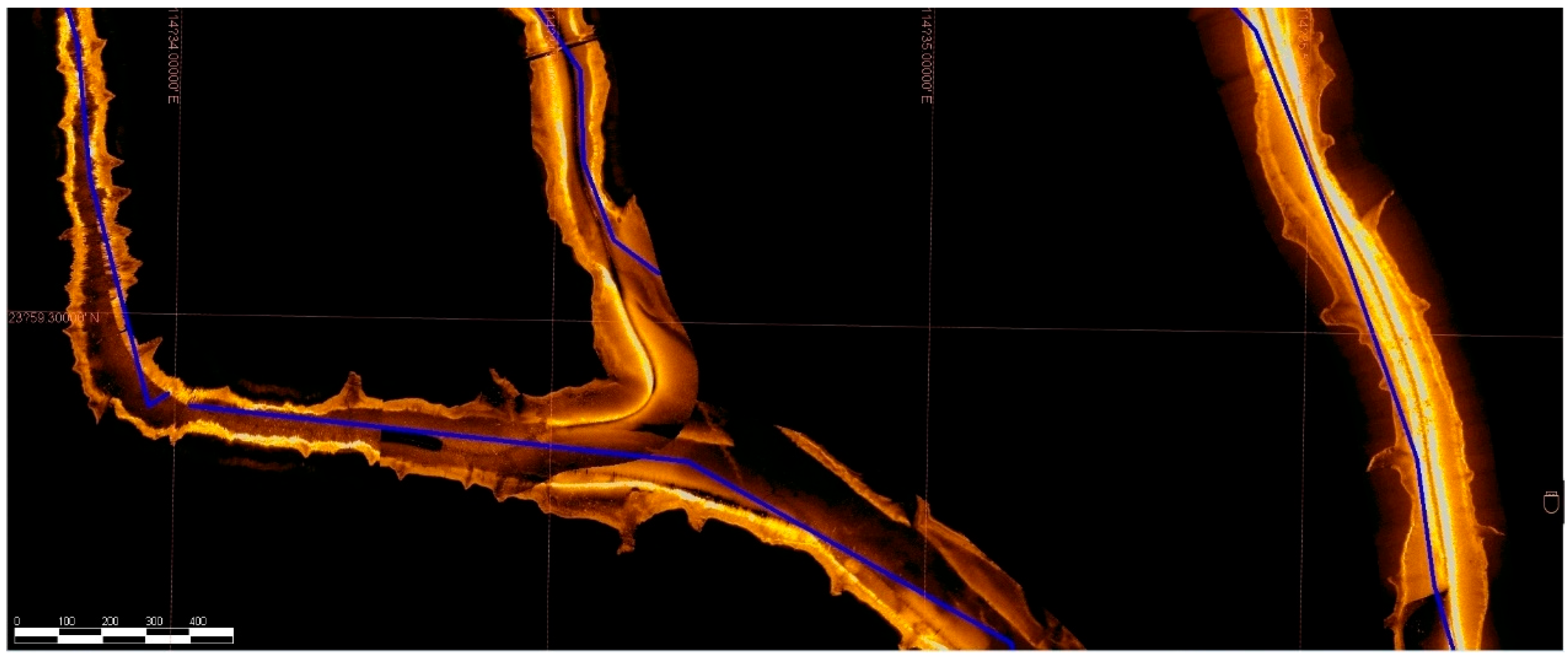


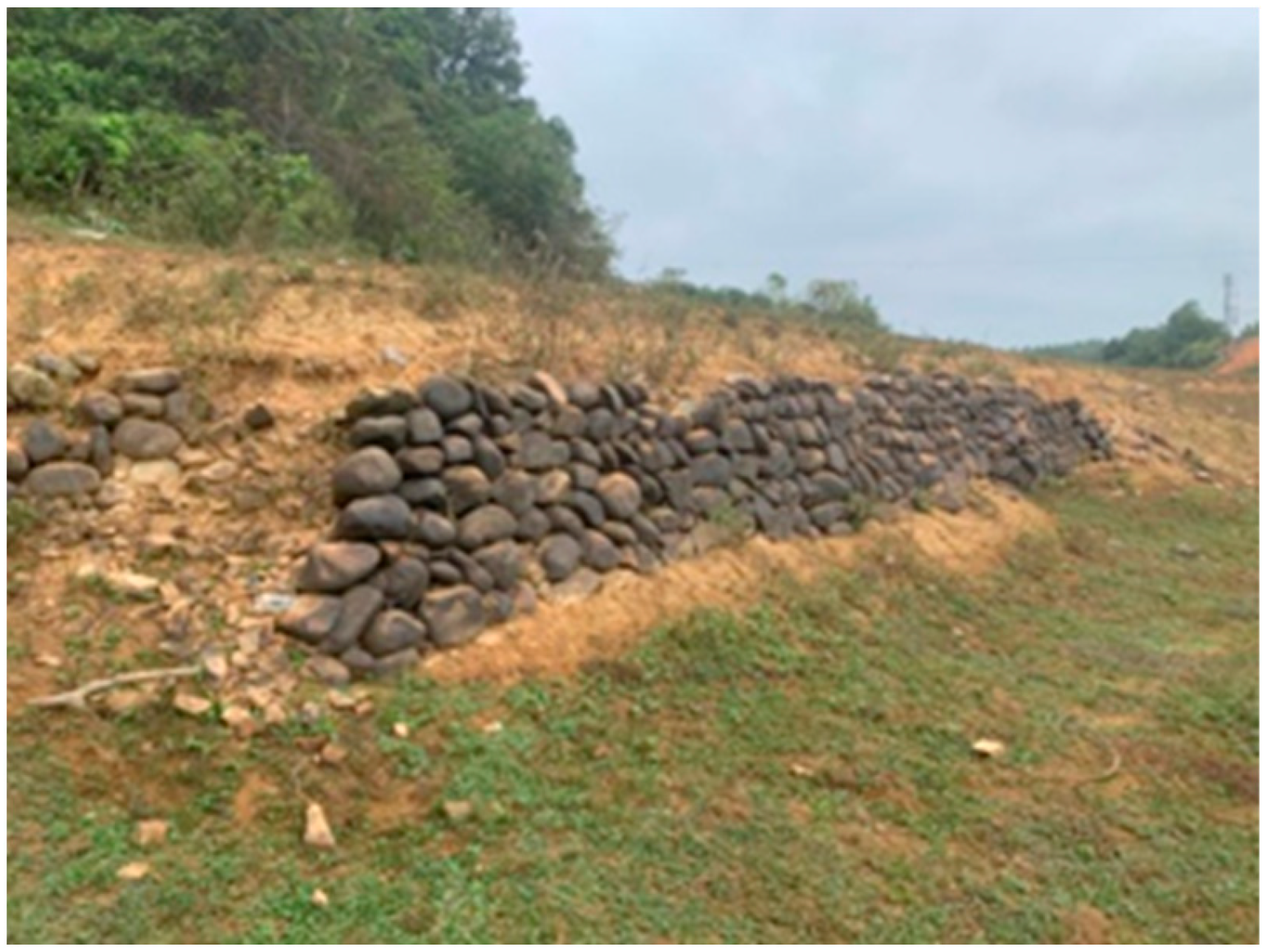

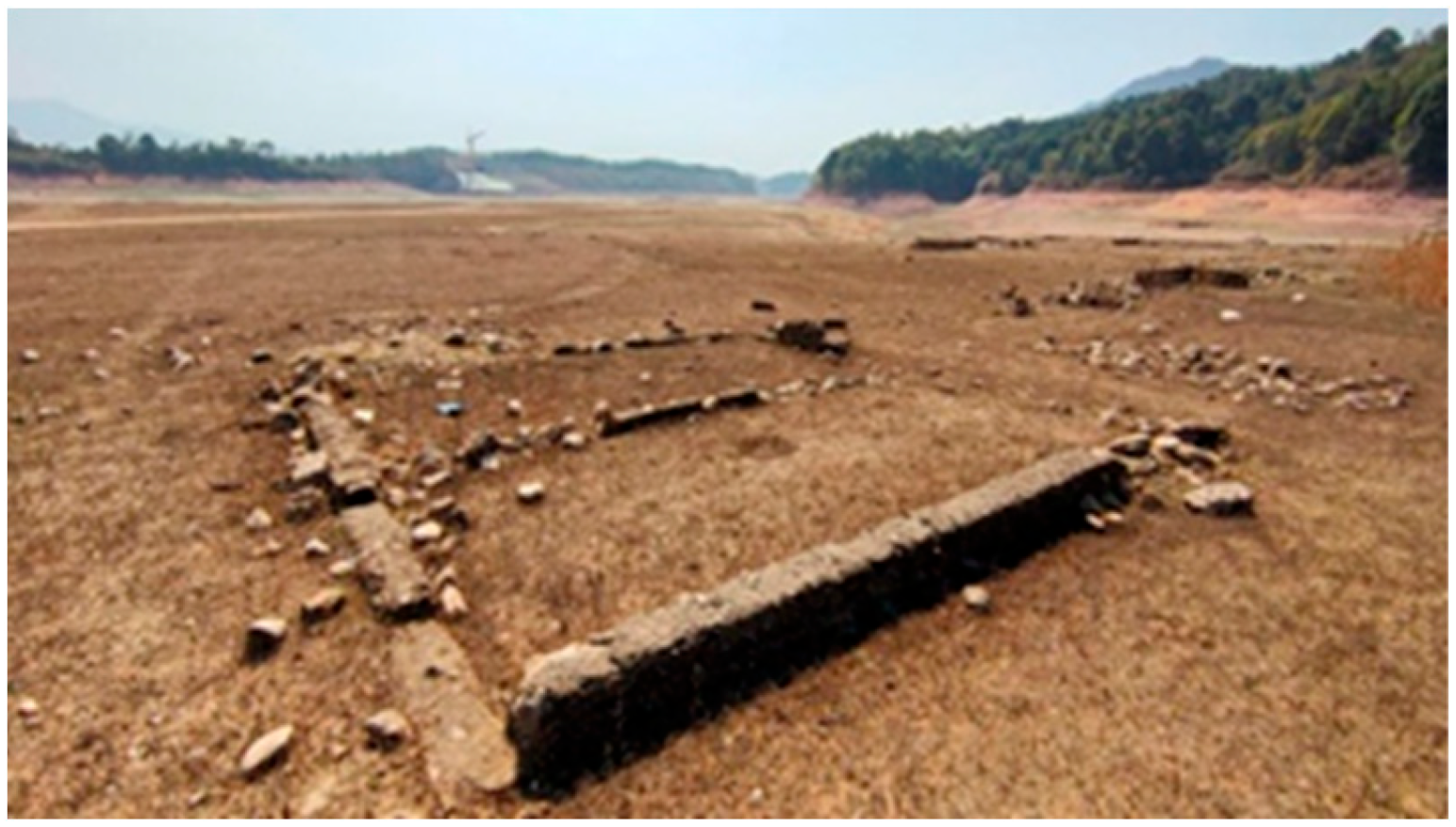
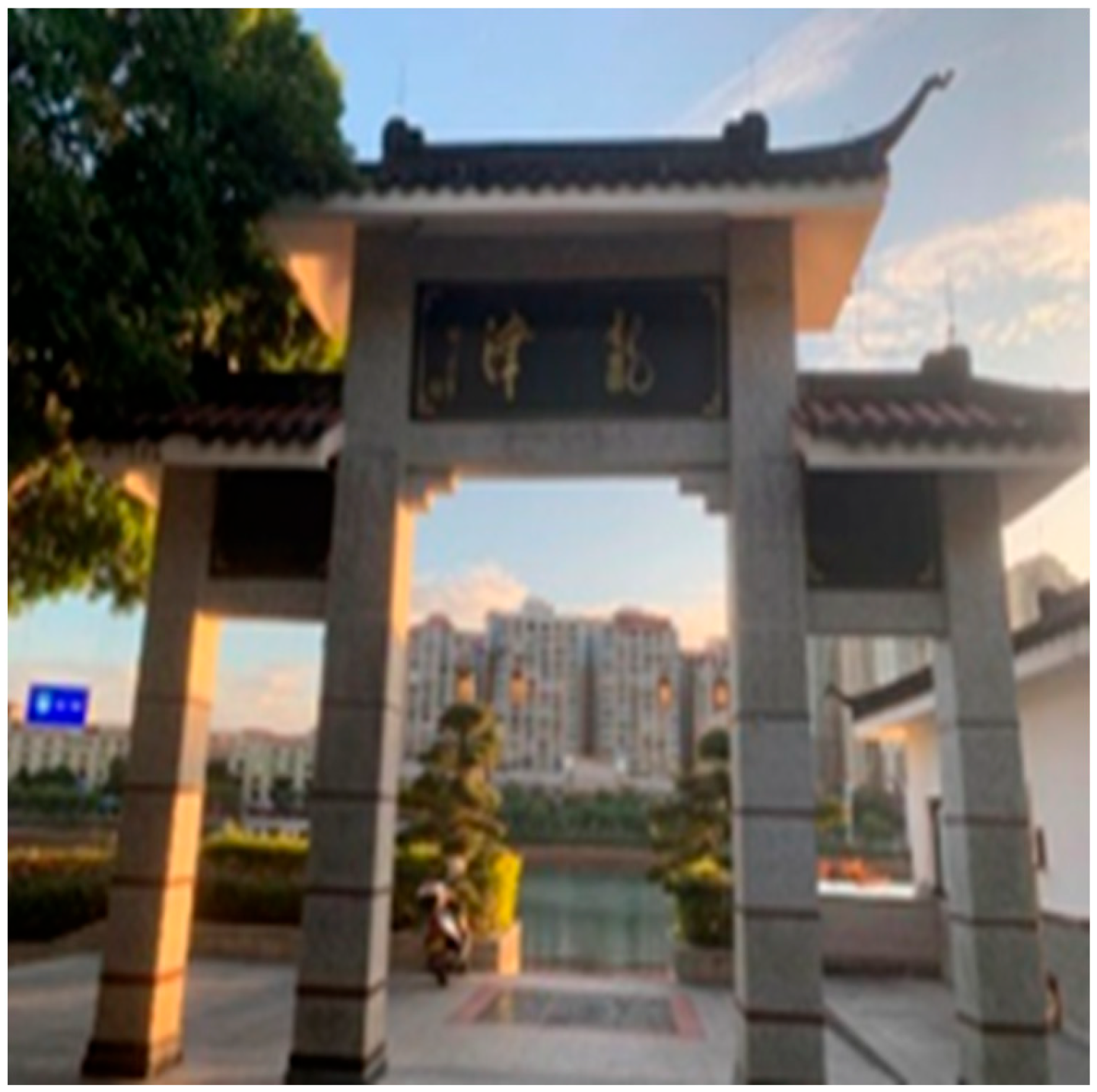






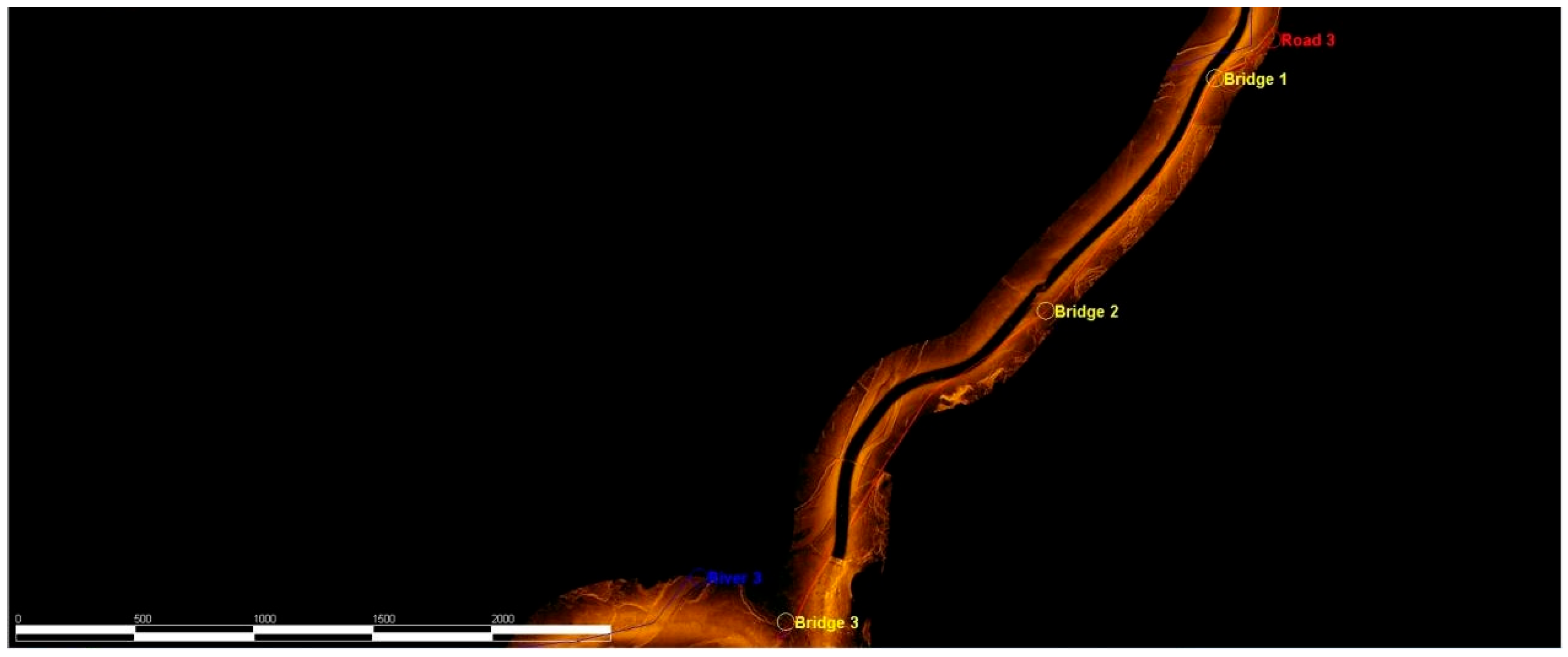

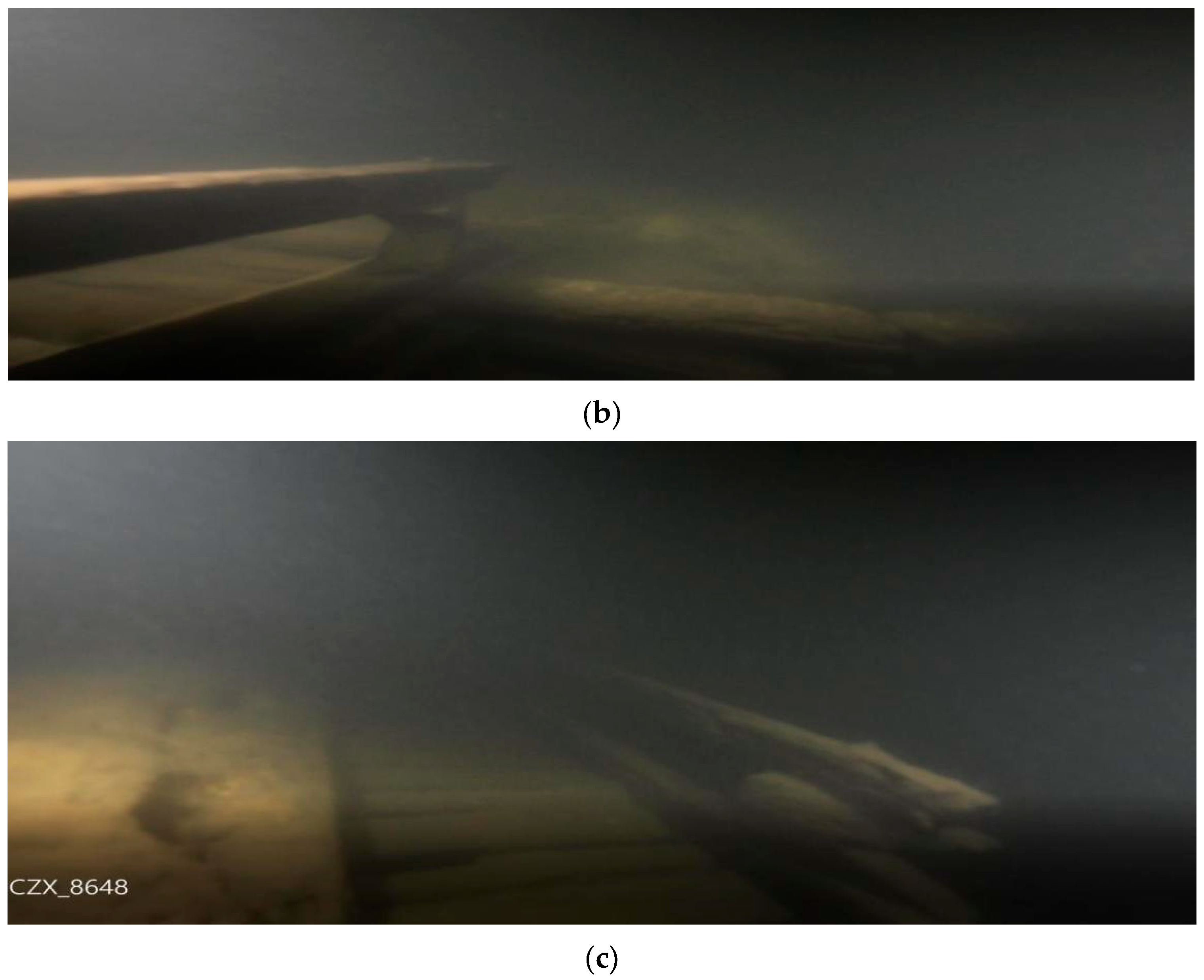


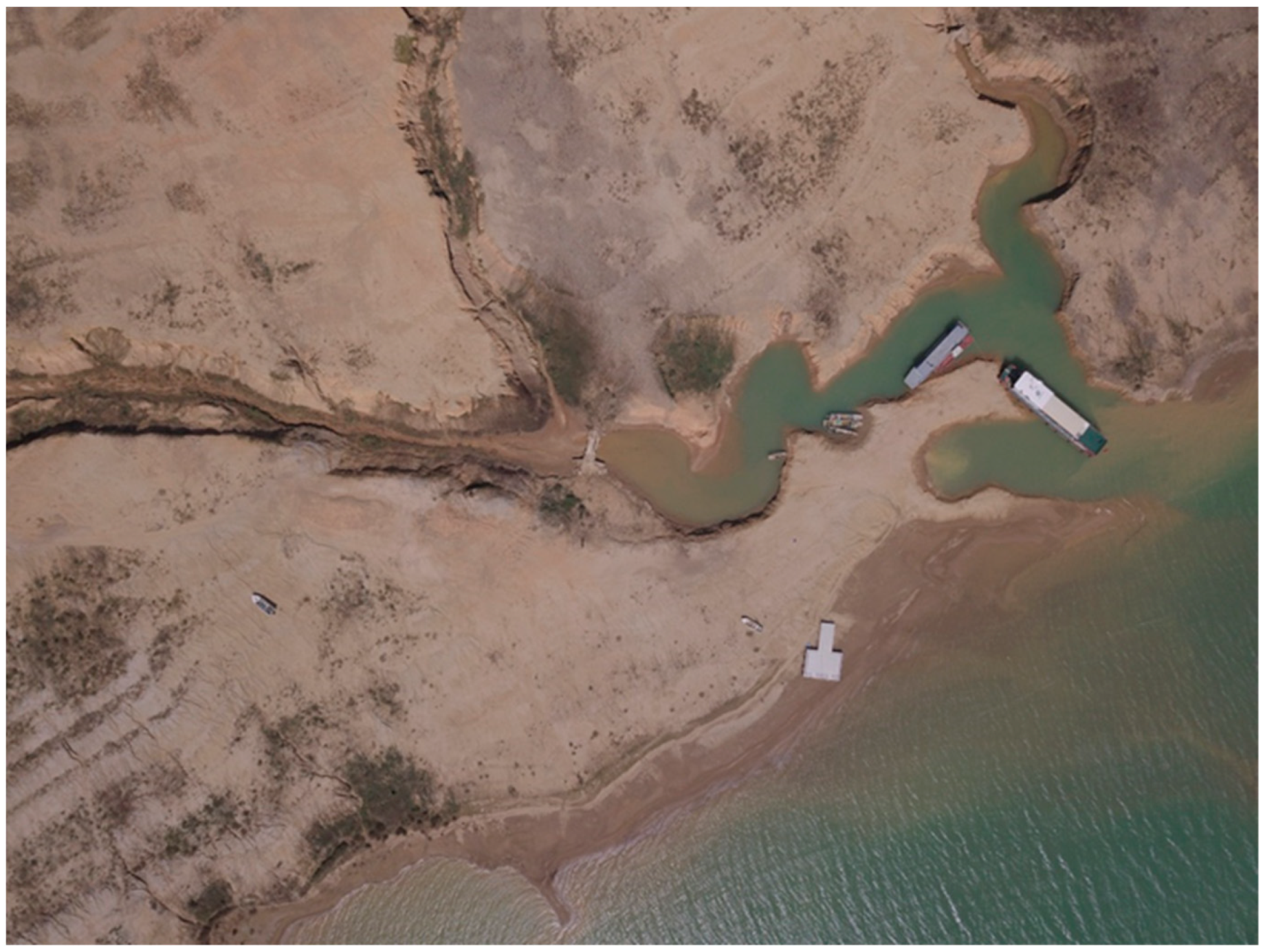
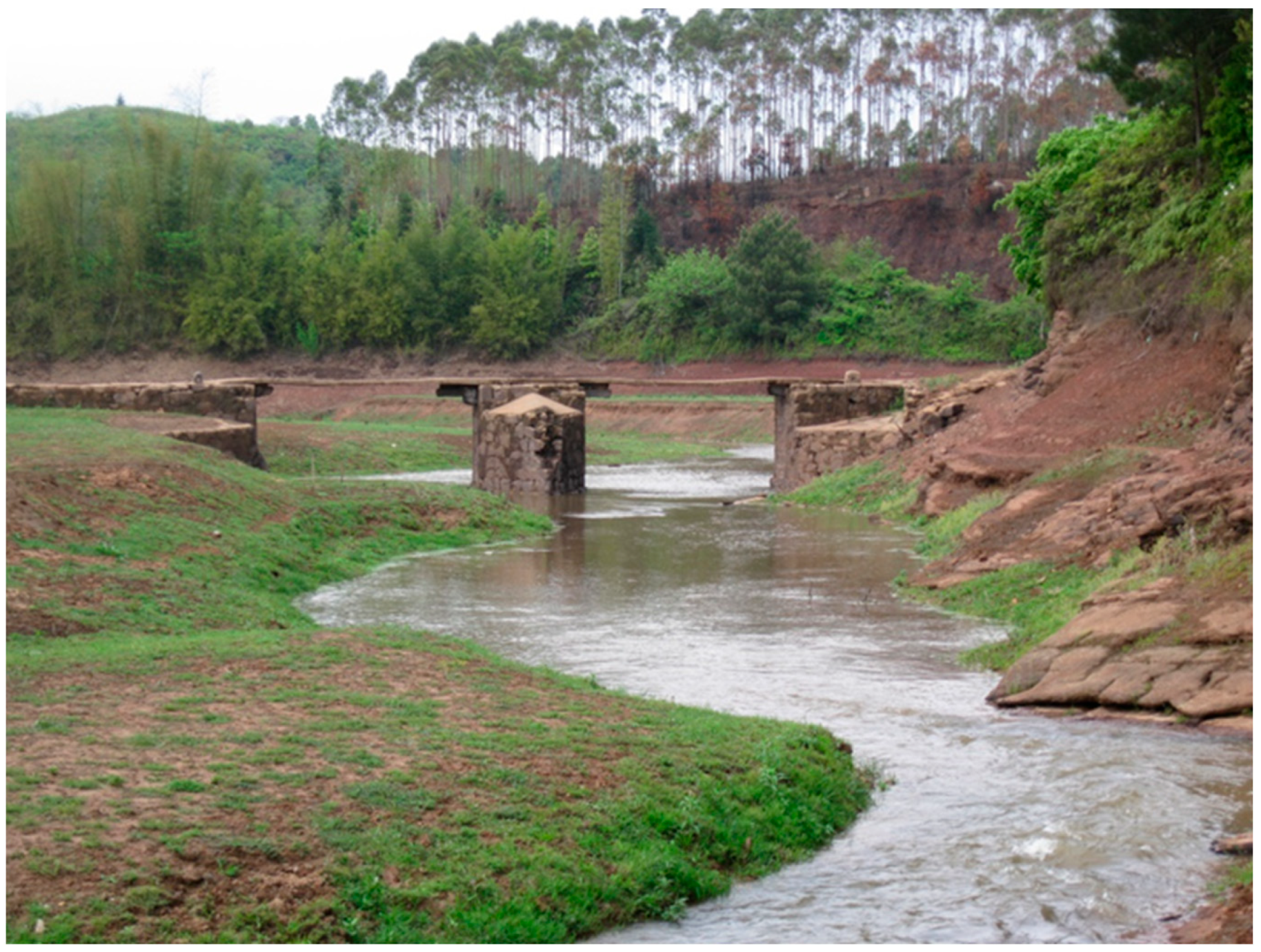

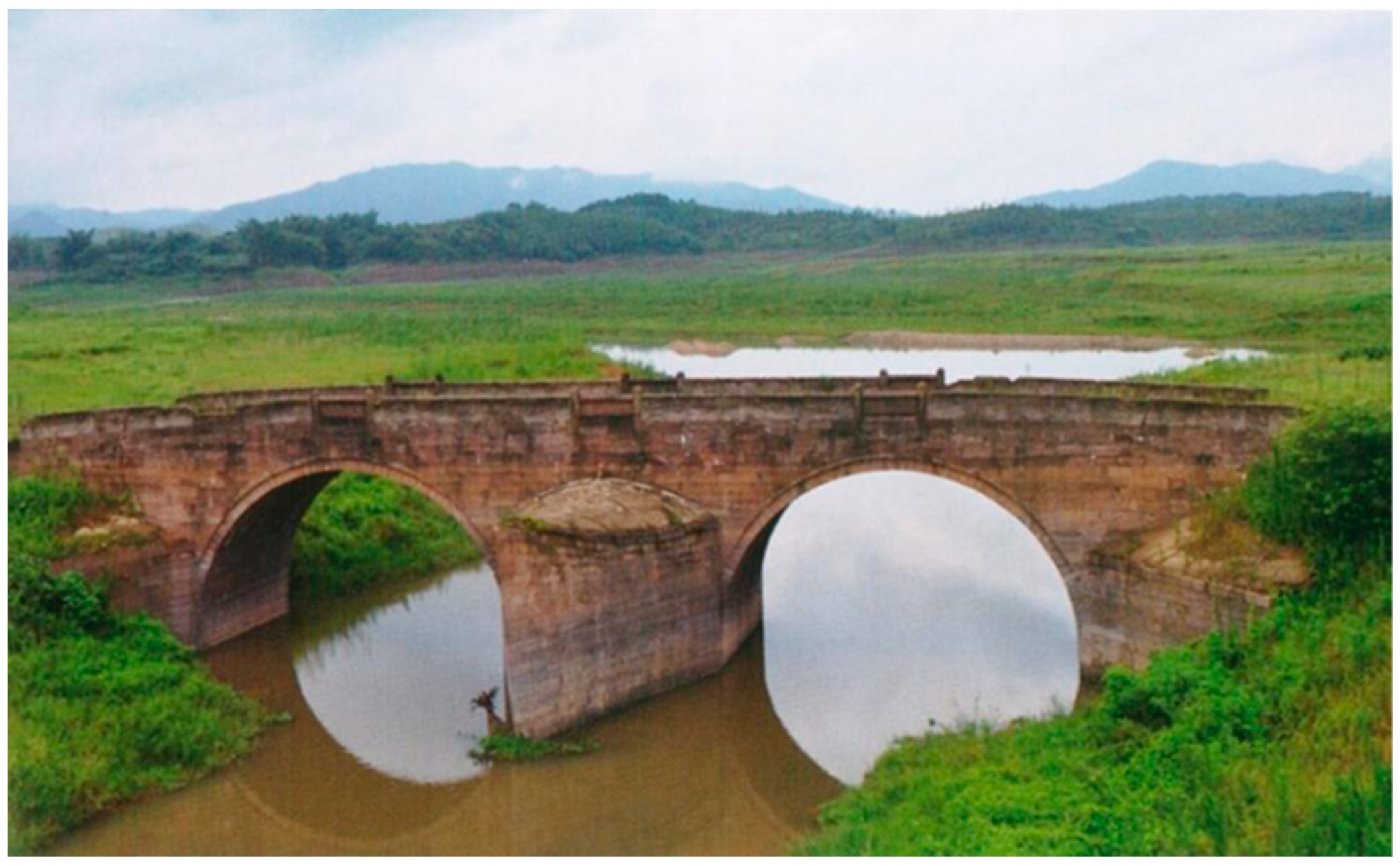
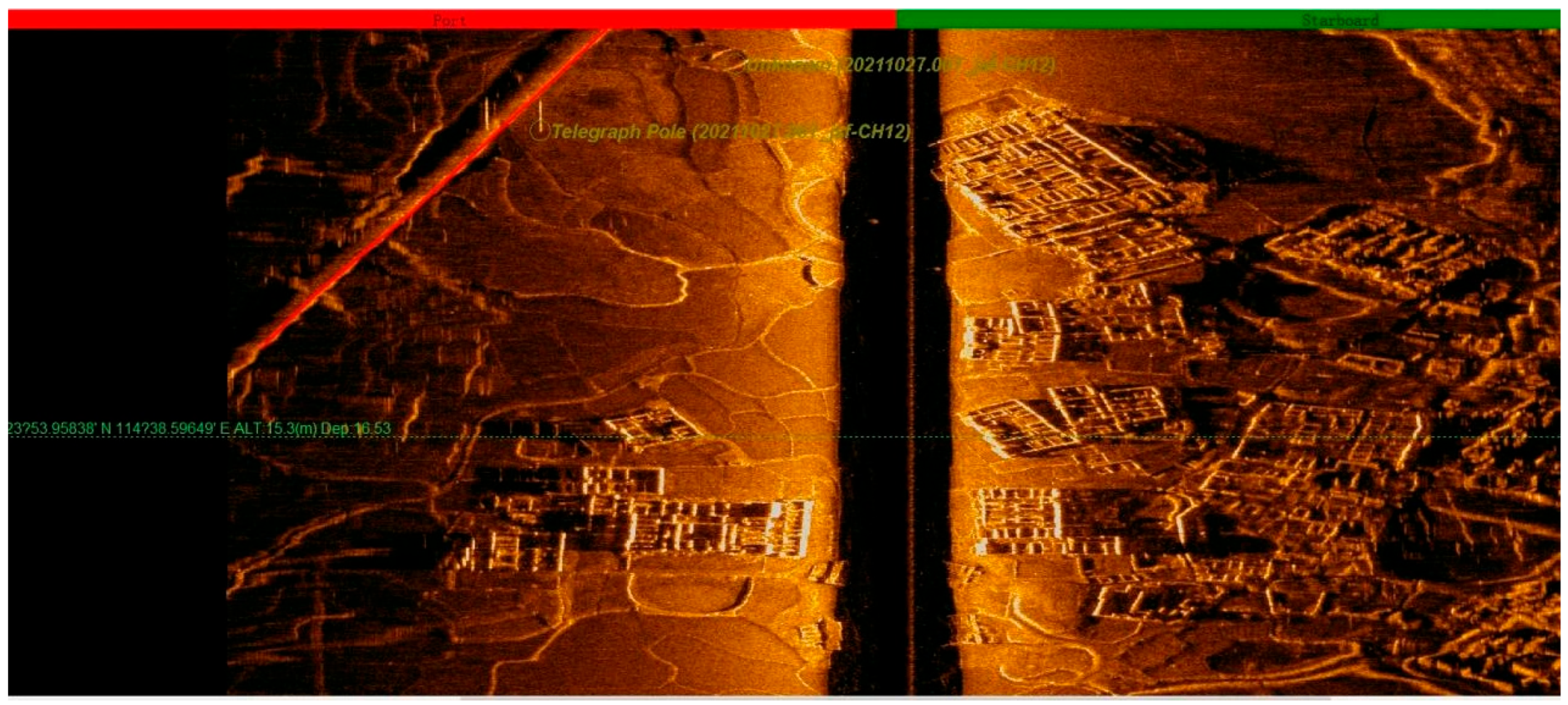

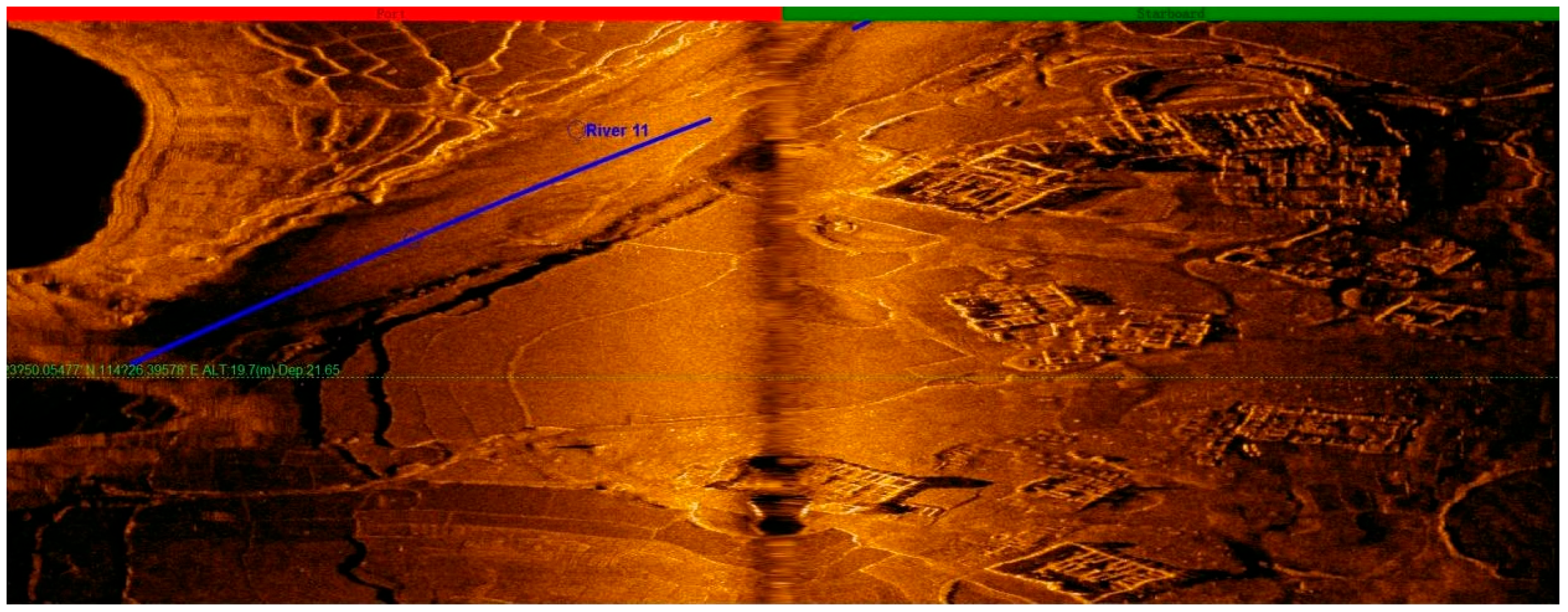
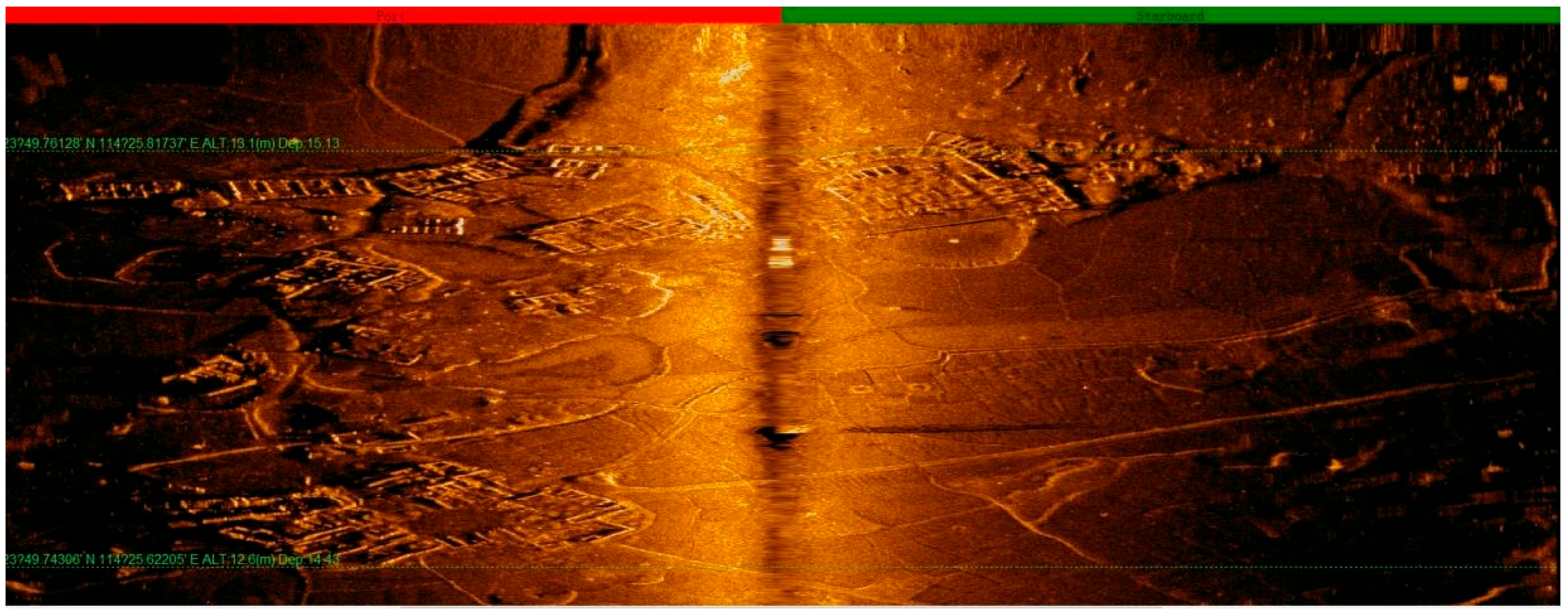
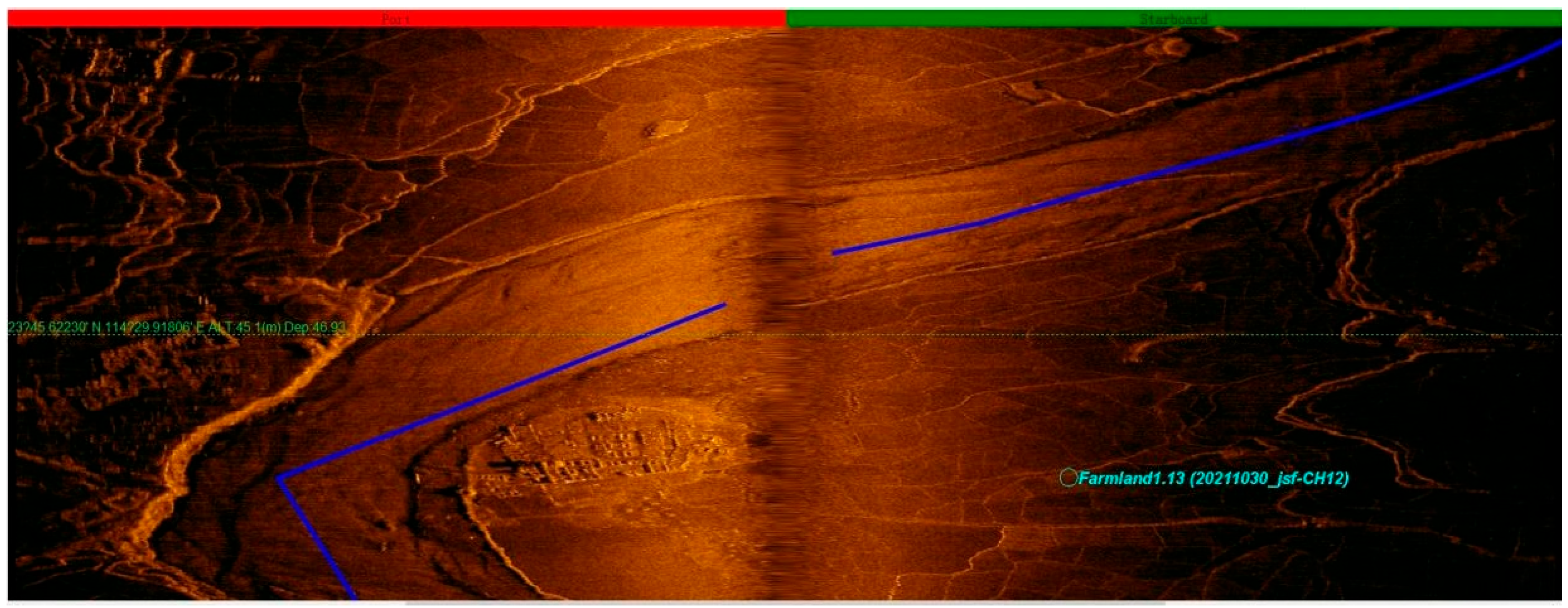
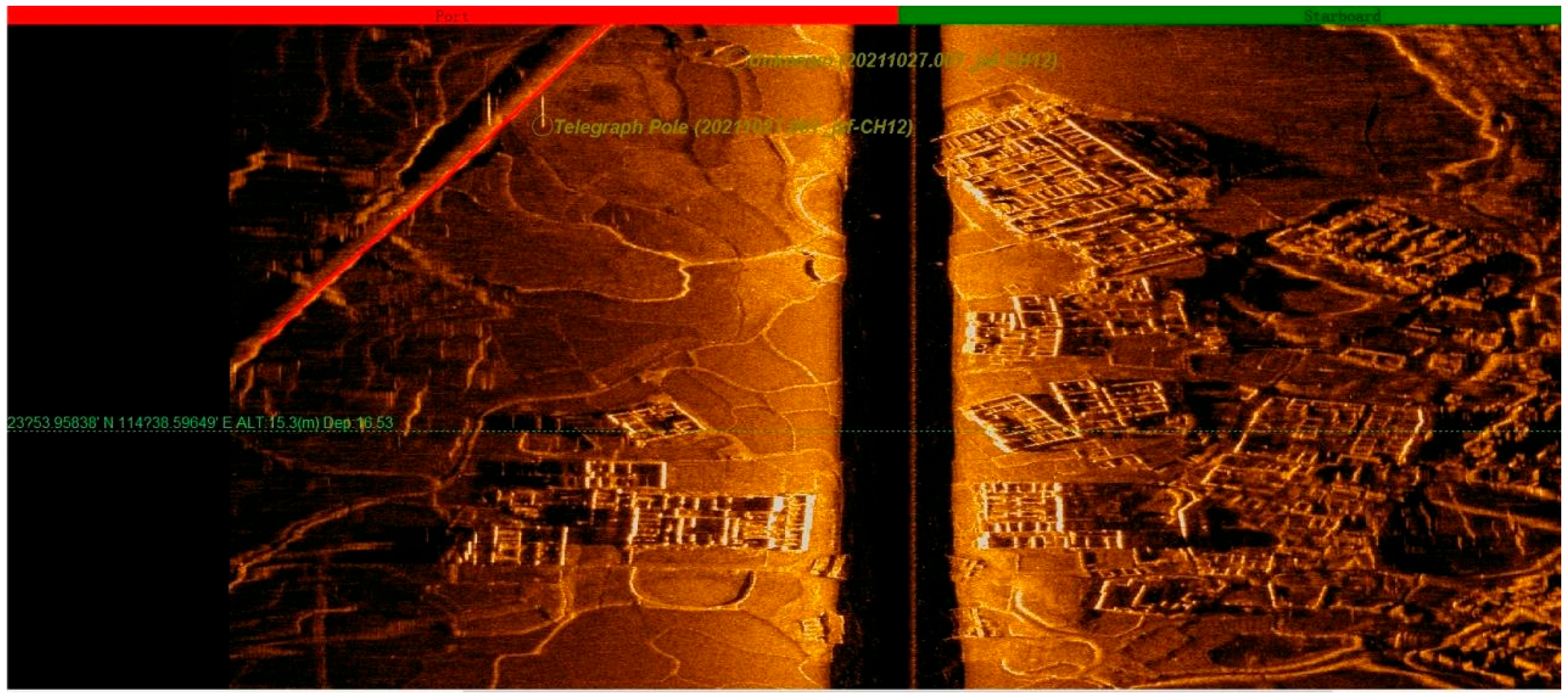

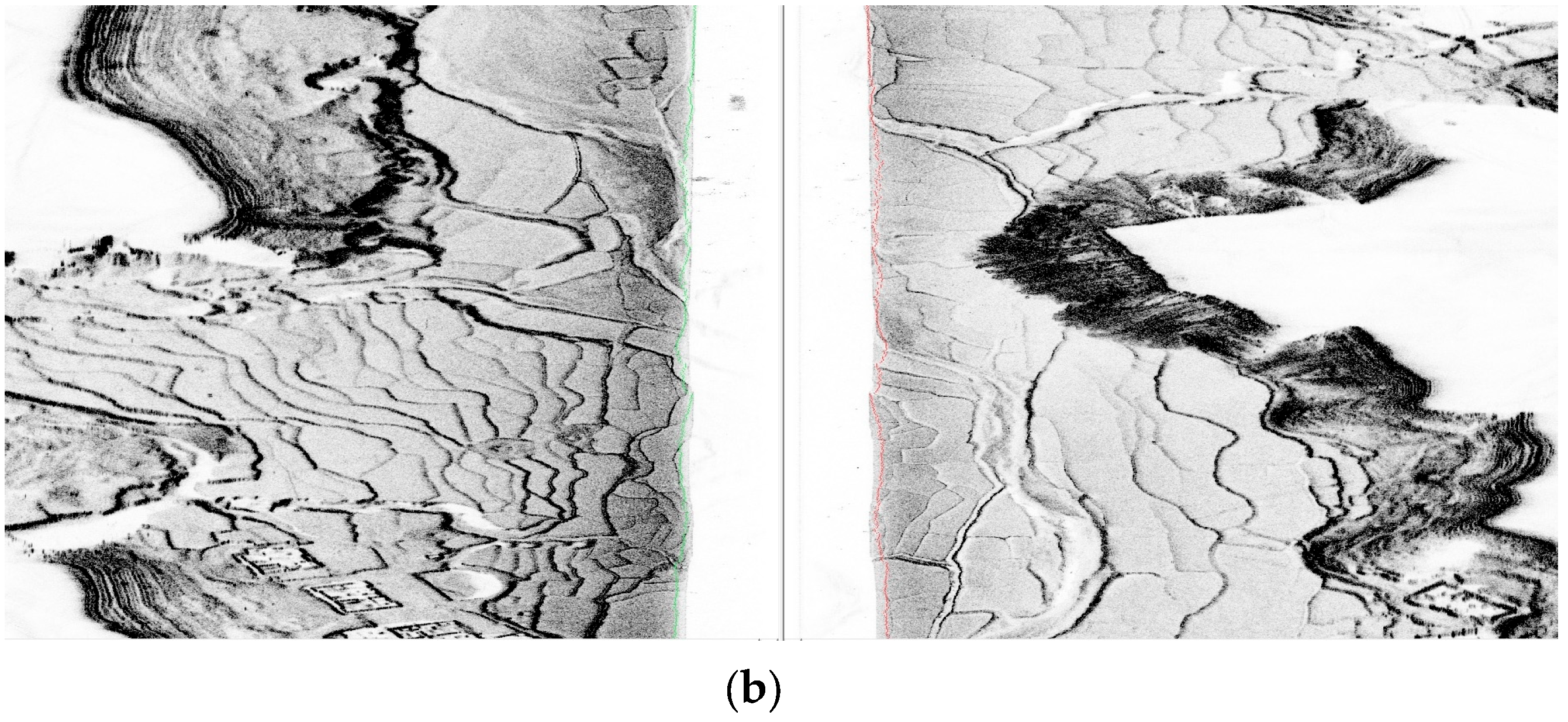
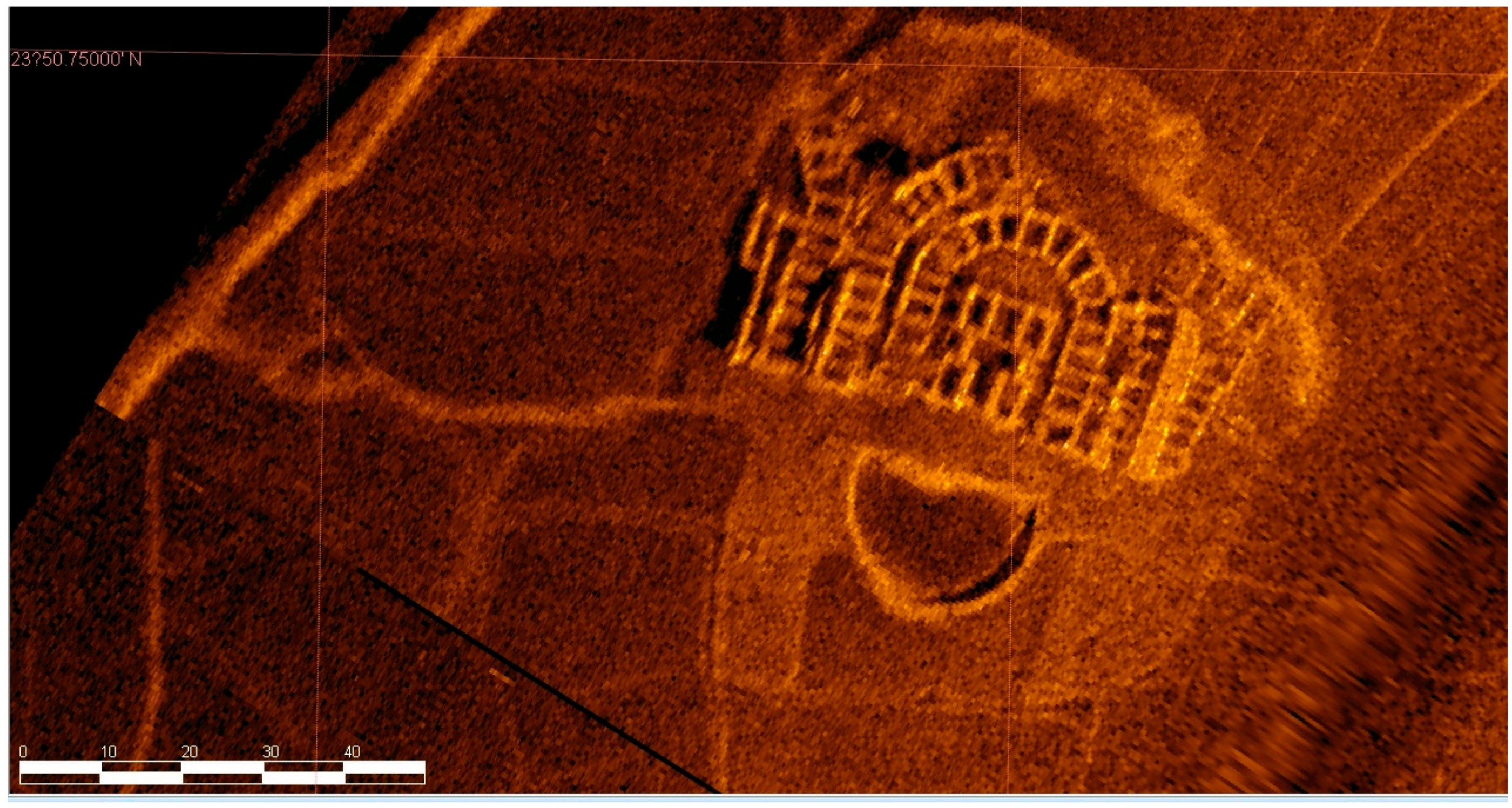
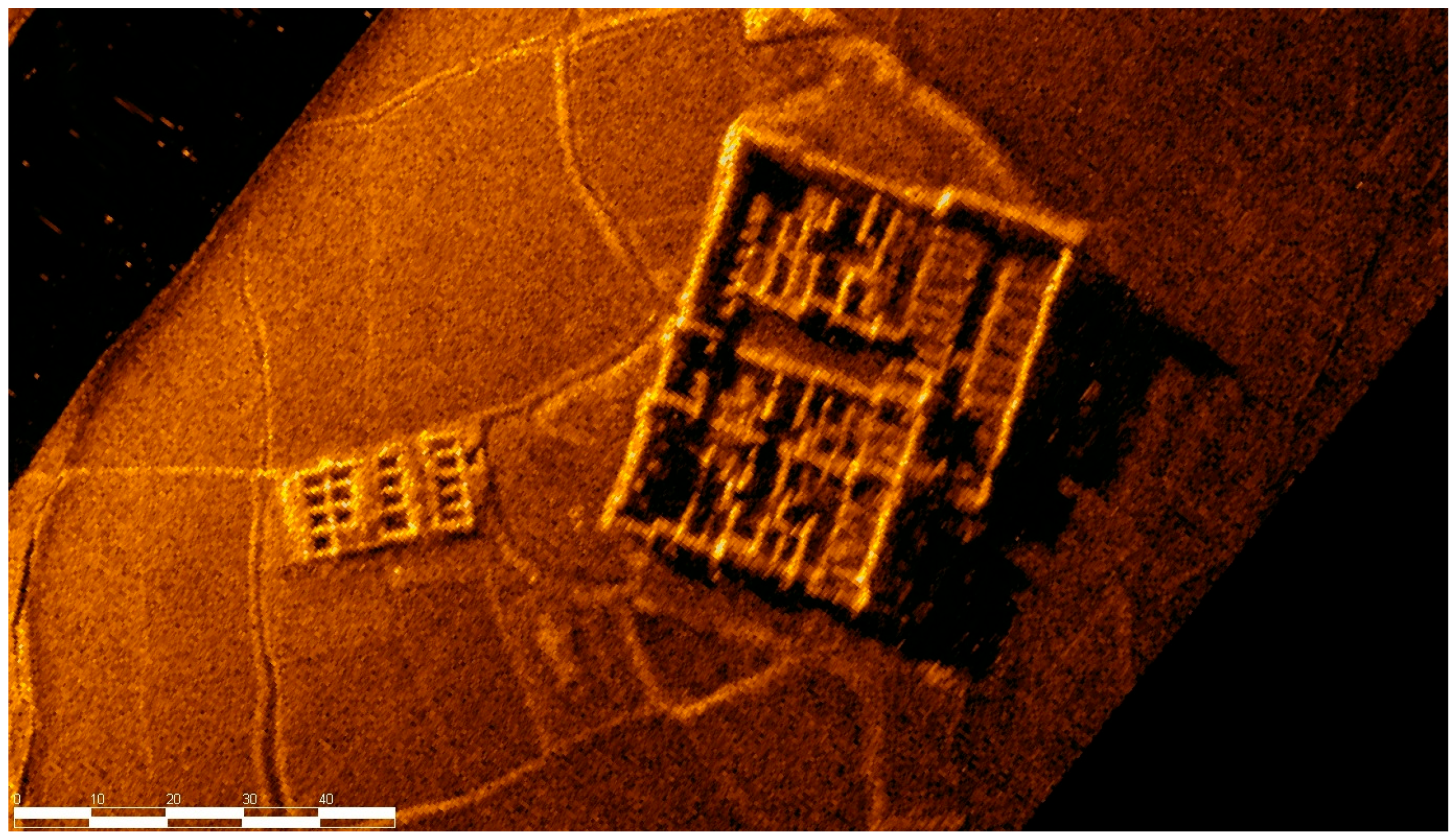

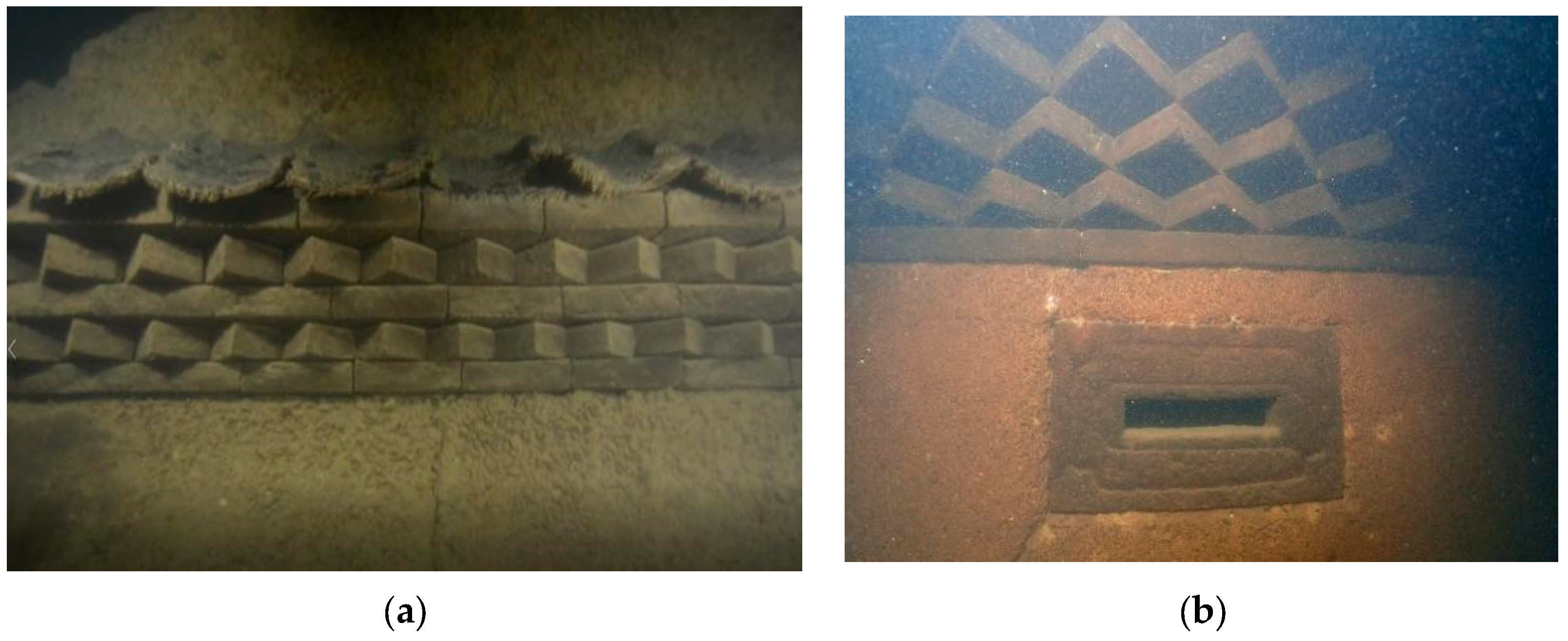


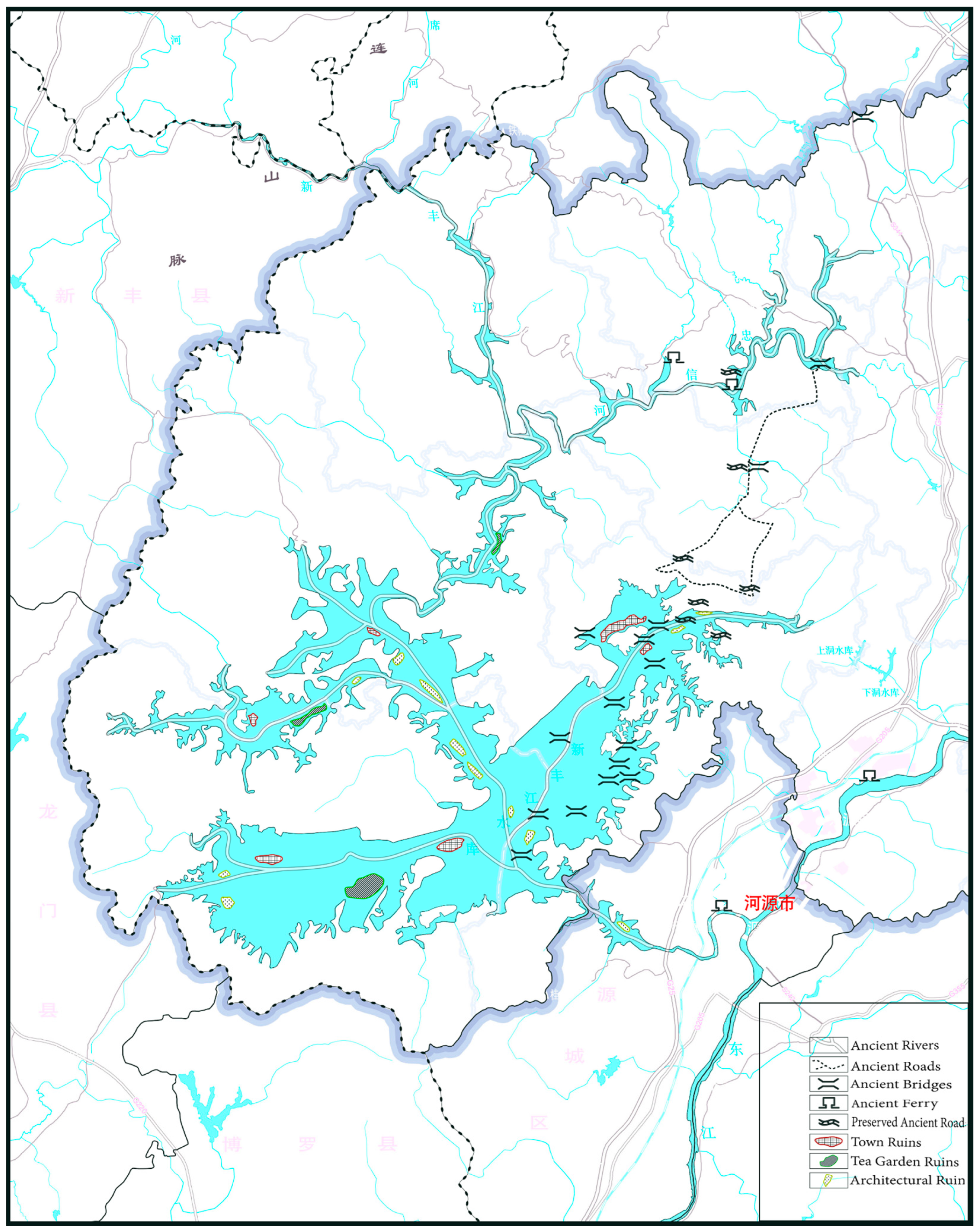
| From Dou’ao to Shuangjiang | |||
|---|---|---|---|
| No. | Longitudes | Latitudes | Estimated building materials |
| SB | 23°52.91310′ | 114°38.74606′ | Stone bridge |
| B1.4 | 23°53.71674′ | 114°38.69184′ | Wooden bridge |
| B1.5 | 23°53.07900′ | 114°38.72358′ | Wooden bridge |
| From Nanhu Market to Dou’ao | |||
| No. | Longitudes | Latitudes | Estimated building materials |
| B1.6 | 23°50.97576′ | 114°37.30085′ | Wooden bridge |
| B2.0 | 23°52.23776′ | 114°38.34013′ | Wooden bridge |
| D1.1 | 23°50.19382′ | 114°36.25191′ | Dam |
| From Nanhu Village to Yinglong | |||
| No. | Longitudes | Latitudes | Estimated building materials |
| b. | 23°48.54372′ | 114°37.08710′ | Wooden bridge |
| B1.0 | 23°48.50048′ | 114°36.98262′ | Wooden bridge |
| B1.3 | 23°48.28235′ | 114°37.03913′ | Broken |
| B1.10 | 23°48.06495′ | 114°37.17108′ | Broken |
| D | 23°47.86100′ | 114°36.42791′ | Dam |
| B1.8 | 23°47.49683′ | 114°35.03980′ | Long wooden bridge (more than 50 m long) |
| Huilong Town to today’s Dazhakou | |||
| No. | Longitudes | Latitudes | Estimated building materials |
| SB1.1 | 23°46.26951′ | 114°34.43631′ | Stone dam/stone bridge |
| Xuchang Village | |||
| No. | Longitudes | Latitudes | Estimated building materials |
| B1.9 | 23°52.92484′ | 114°28.47589′ | Narrow wooden bridge |
Disclaimer/Publisher’s Note: The statements, opinions and data contained in all publications are solely those of the individual author(s) and contributor(s) and not of MDPI and/or the editor(s). MDPI and/or the editor(s) disclaim responsibility for any injury to people or property resulting from any ideas, methods, instructions or products referred to in the content. |
© 2024 by the authors. Licensee MDPI, Basel, Switzerland. This article is an open access article distributed under the terms and conditions of the Creative Commons Attribution (CC BY) license (https://creativecommons.org/licenses/by/4.0/).
Share and Cite
Zhang, S.; He, M.; Dong, G.; Wang, X. New Perceptions of Ancient Commerce Driven by Underwater Ancient Site Investigations: A Case Study of Xinfeng River Basin. Heritage 2024, 7, 2313-2347. https://doi.org/10.3390/heritage7050110
Zhang S, He M, Dong G, Wang X. New Perceptions of Ancient Commerce Driven by Underwater Ancient Site Investigations: A Case Study of Xinfeng River Basin. Heritage. 2024; 7(5):2313-2347. https://doi.org/10.3390/heritage7050110
Chicago/Turabian StyleZhang, Song, Ming He, Guoliang Dong, and Xianying Wang. 2024. "New Perceptions of Ancient Commerce Driven by Underwater Ancient Site Investigations: A Case Study of Xinfeng River Basin" Heritage 7, no. 5: 2313-2347. https://doi.org/10.3390/heritage7050110
APA StyleZhang, S., He, M., Dong, G., & Wang, X. (2024). New Perceptions of Ancient Commerce Driven by Underwater Ancient Site Investigations: A Case Study of Xinfeng River Basin. Heritage, 7(5), 2313-2347. https://doi.org/10.3390/heritage7050110





